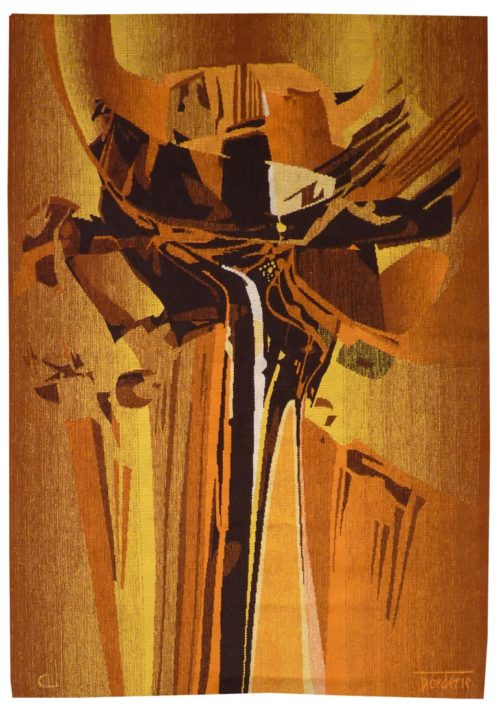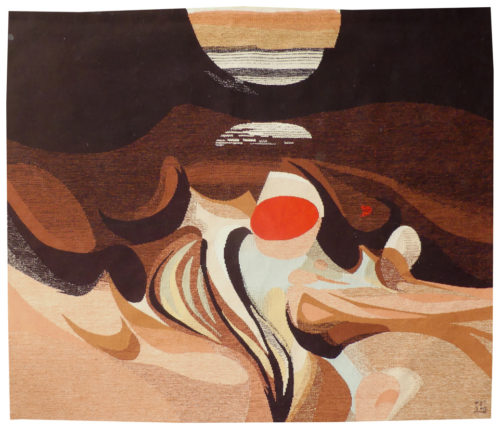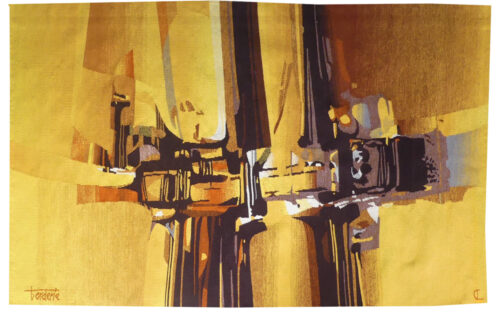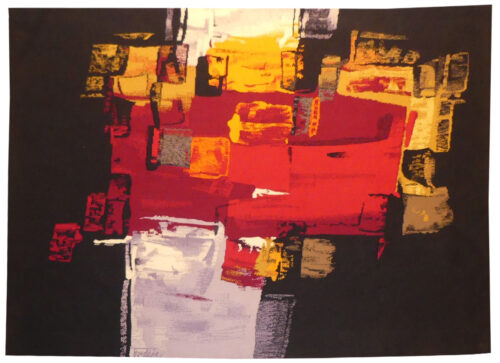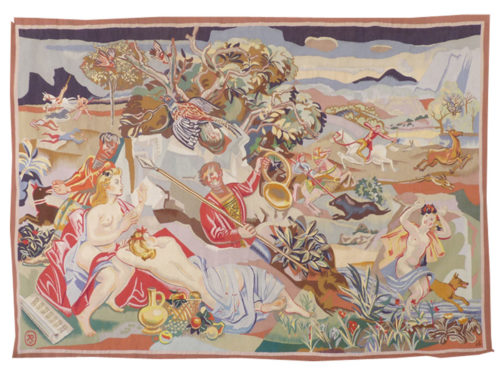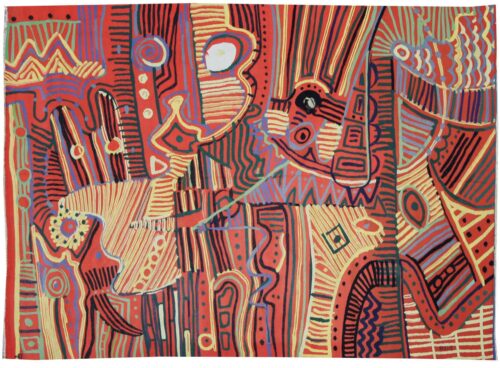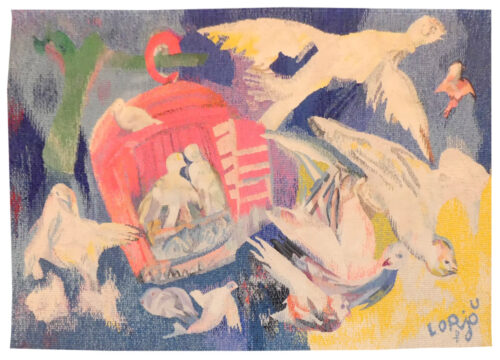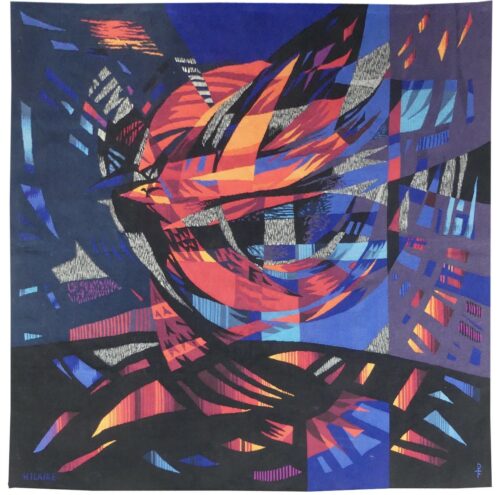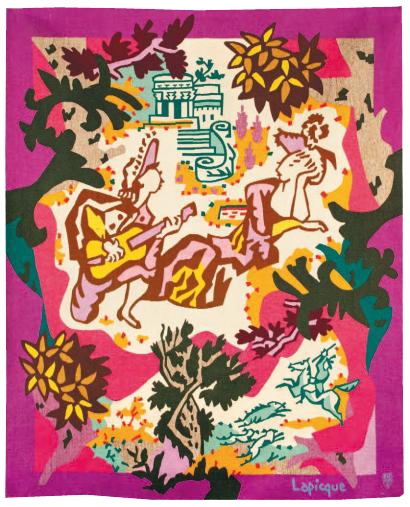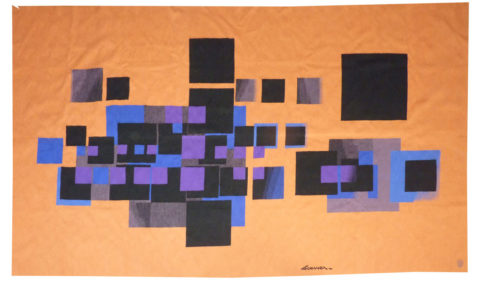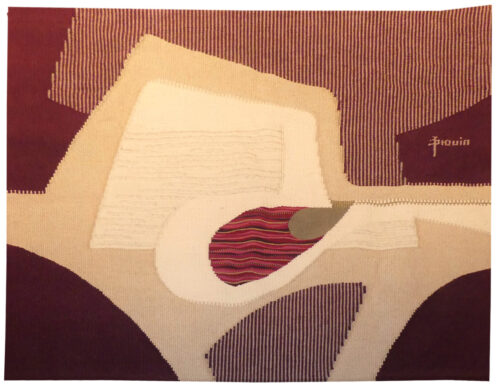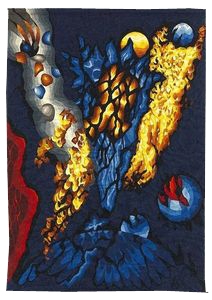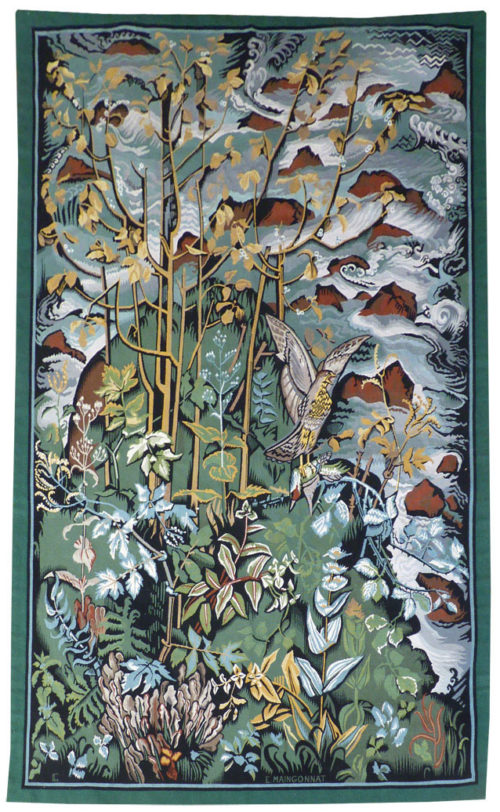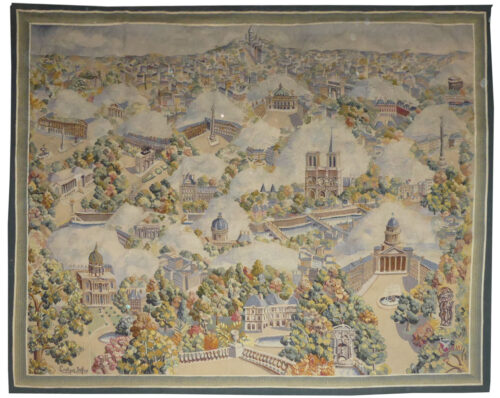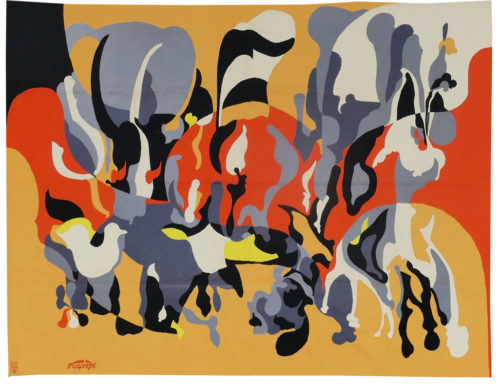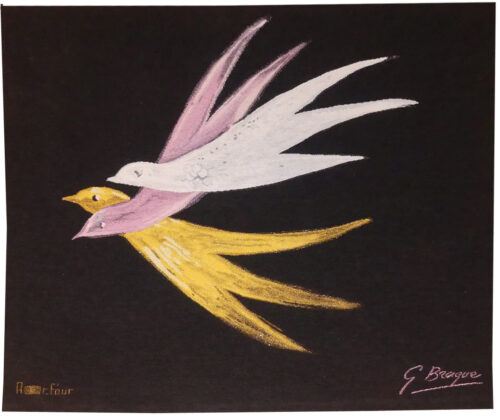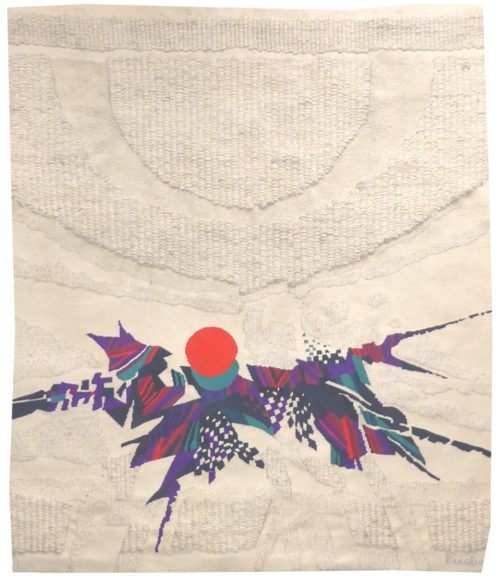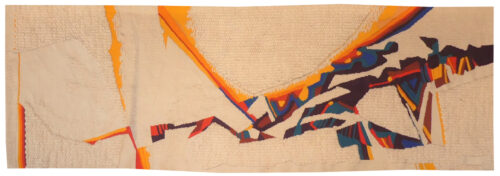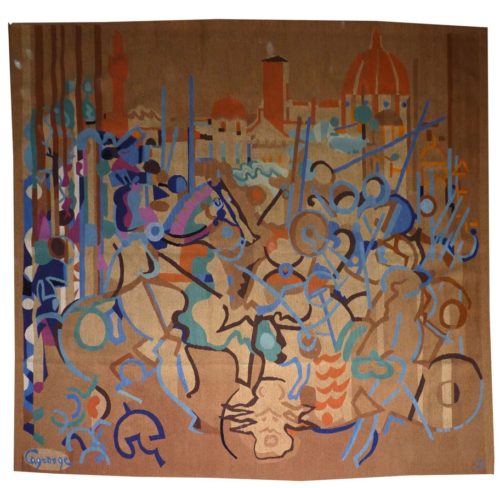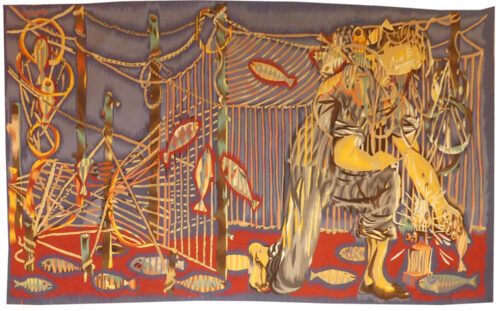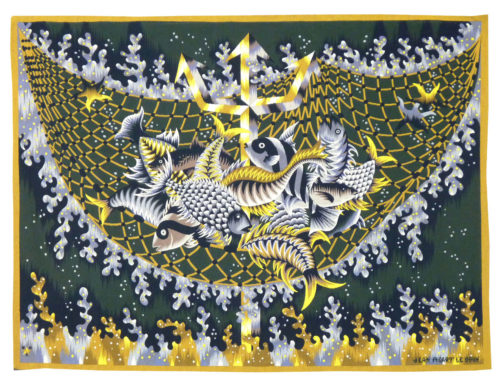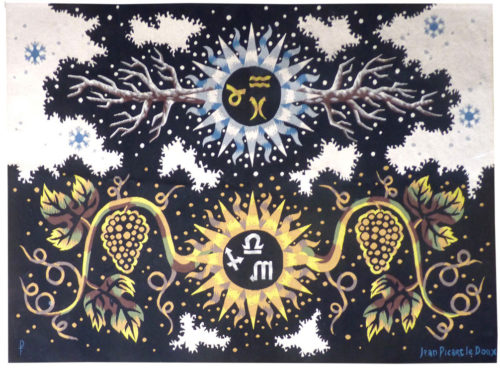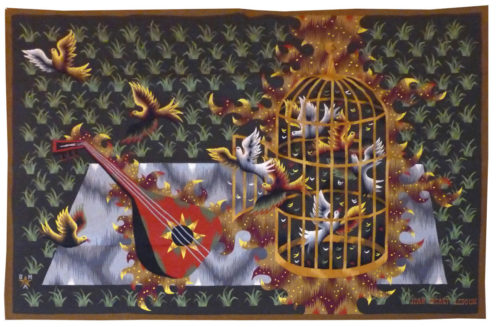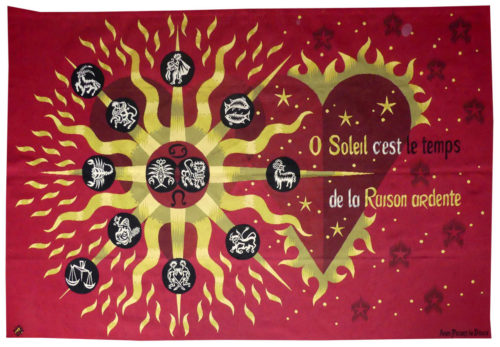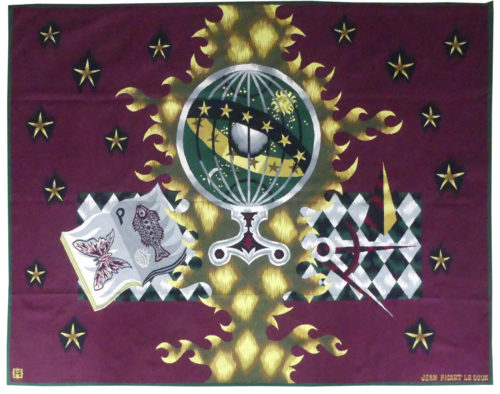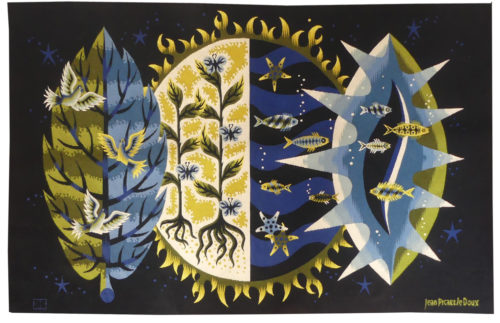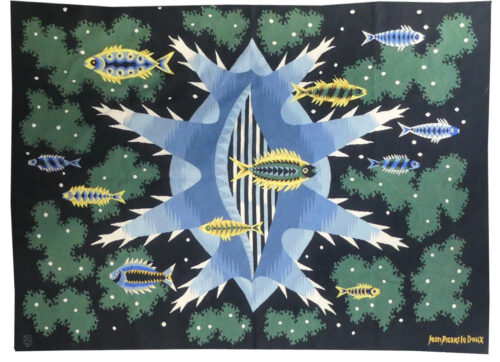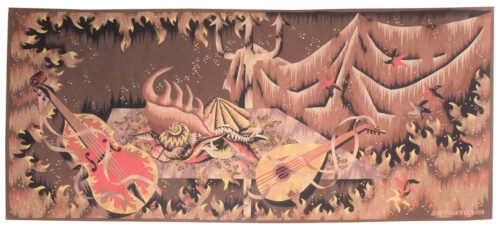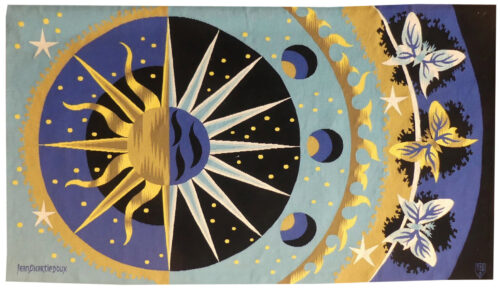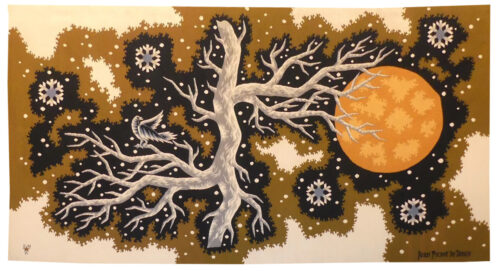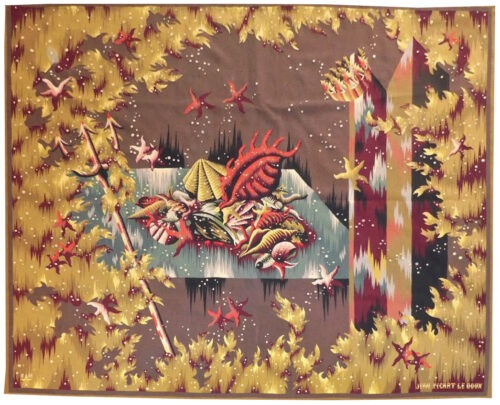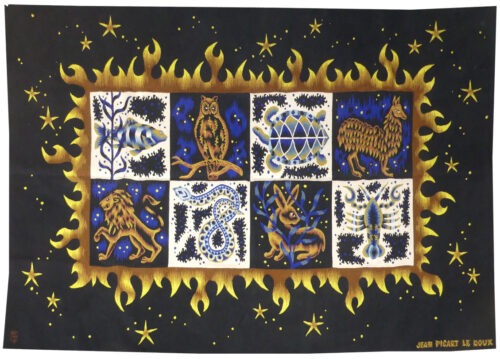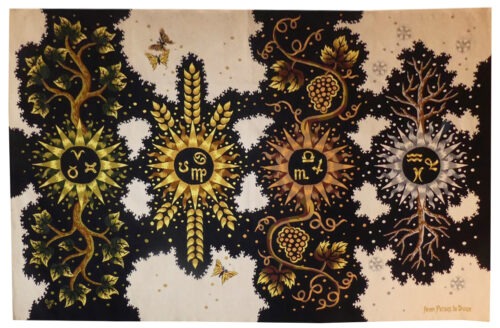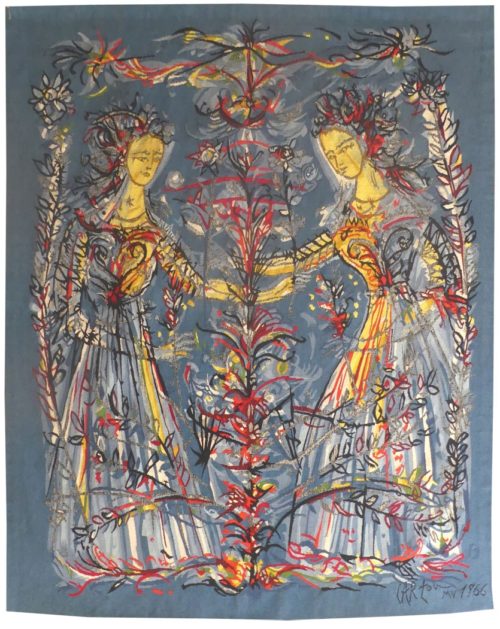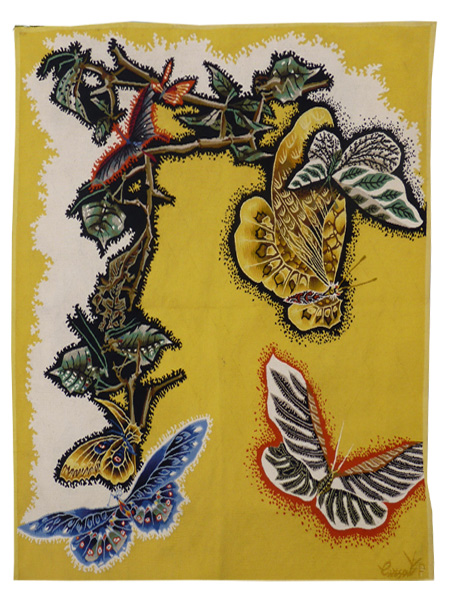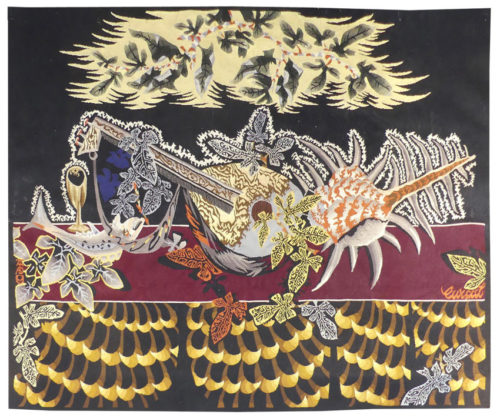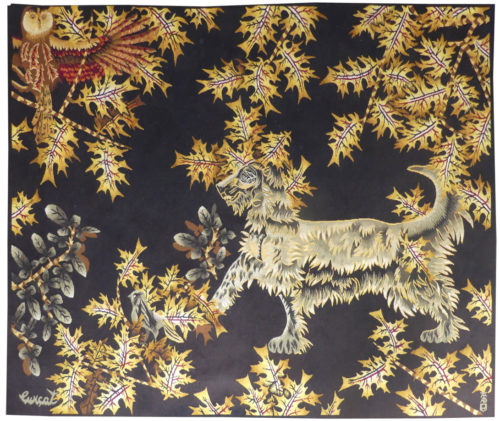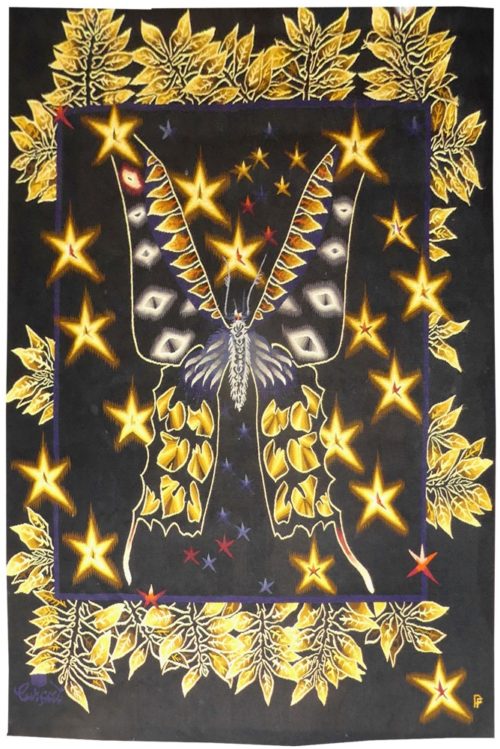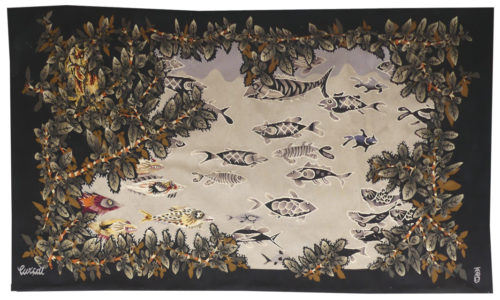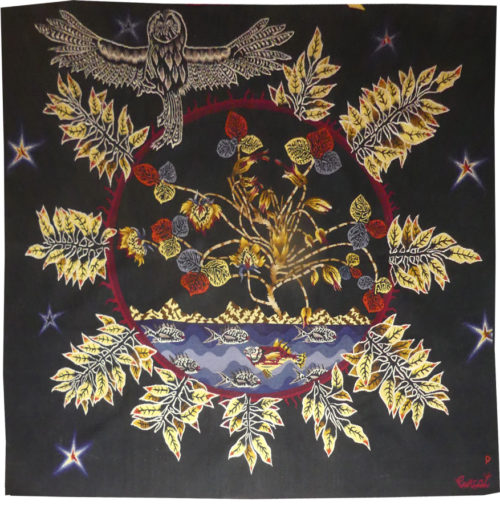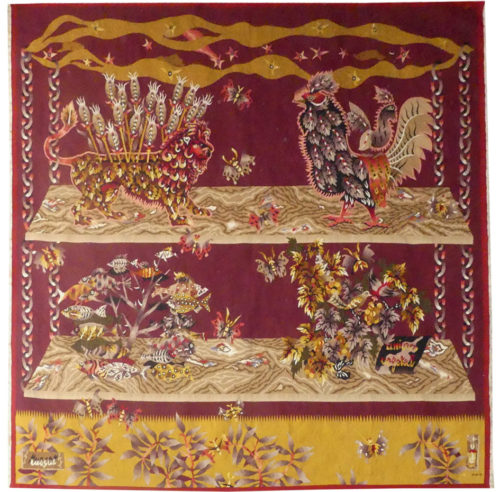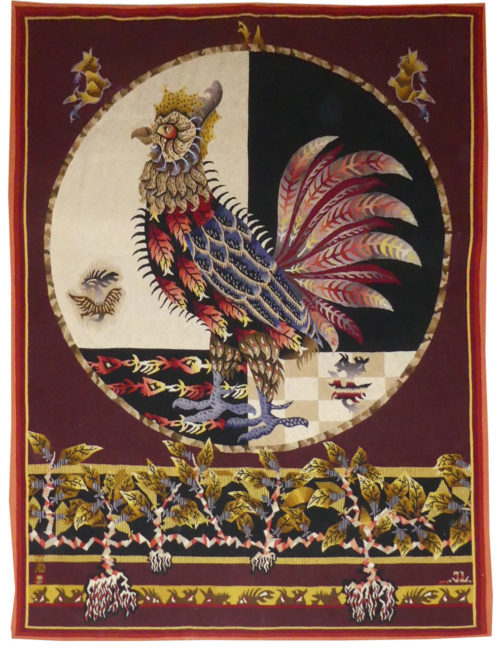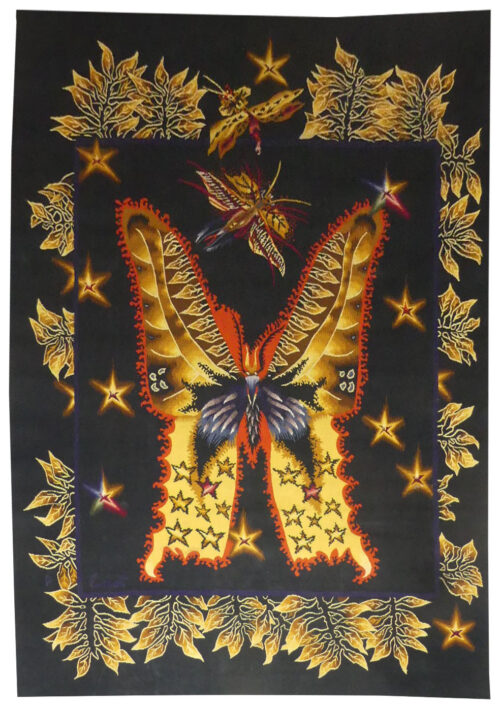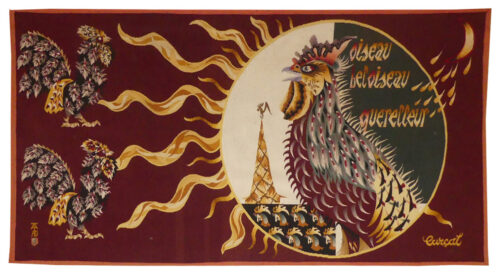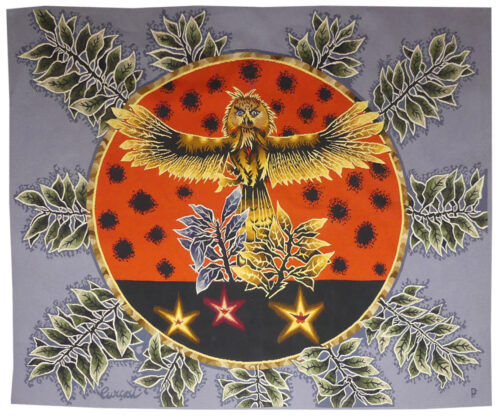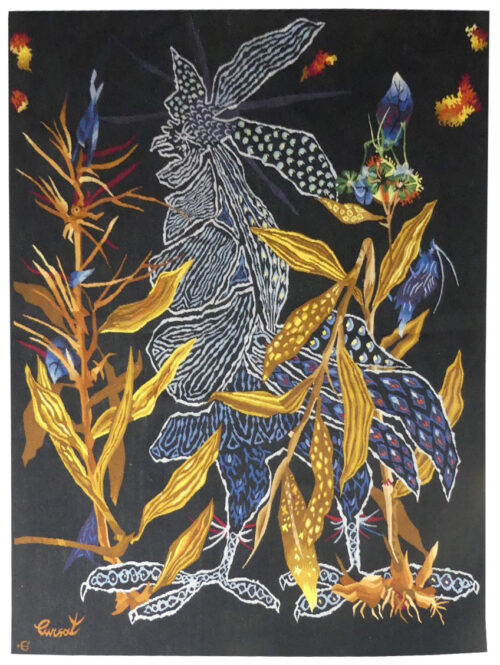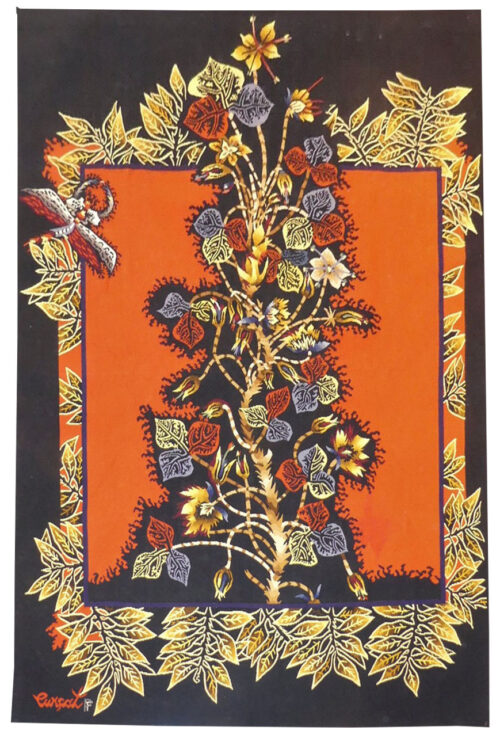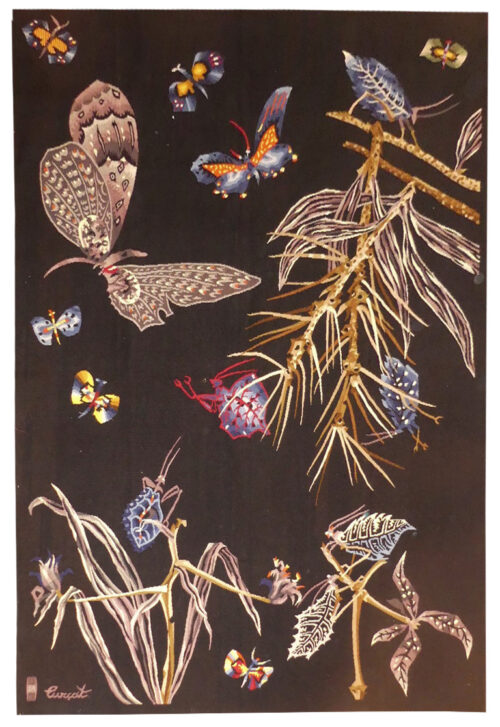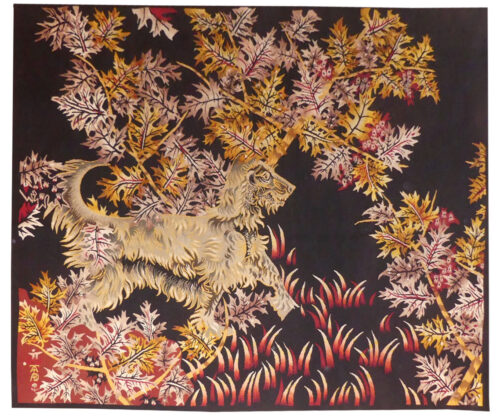-
Aubusson tapestry woven in the Legoueix workshop. Complete with signed label, n°1/6. Circa 1970.Originally a sculptor exploiting very diverse materials (steel, concrete, clay…), Borderie came to tapestry with immense enthusiasm in the 1950’s with the weaving of his first cartoon in 1957. Receiving encouragement from Denise Majorel, he was awarded the Grand Prix National de la Tapisserie in 1962. In 1974 he was appointed as director at the Ecole Nationale des Arts Décoratifs at Aubusson but he resigned from this post shortly thereafter. He designed over 500 painted cartoons, abstracts using simple shapes, shading in a limited palette of colours and weaving with gros points. Despite its warm colours and lyrical shapes (notably the sinuous vertical swirl, ressembling water currents), “Eaux vives” remains a one-off in Borderie’s work : the habitual muted colour scheme is broken here by the striking central red oval. Bibliography : Exhibition catalogue André Borderie « pour l’homme simplement », Angers, Musée Jean Lurçat et de la Tapisserie Contemporaine 1998 J.J. et B. Wattel, André Borderie et la tapisserie d'Aubusson, Editions Louvre Victoire, 2018
-
Vent de sable (sandstorm)
Aubusson tapestry woven in the Legoueix workshop. With signed label, n°EA/2. Circa 1970.Originally a sculptor exploiting very diverse materials (steel, concrete, clay…), Borderie came to tapestry with immense enthusiasm in the 1950’s with the weaving of his first cartoon in 1957. Receiving encouragement from Denise Majorel, he was awarded the Grand Prix National de la Tapisserie in 1962. In 1974 he was appointed as director at the Ecole Nationale des Arts Décoratifs at Aubusson but he resigned from this post shortly thereafter. He designed over 500 painted cartoons, abstracts using simple shapes, shading in a limited palette of colours and weaving with gros points. A dynamic abstraction with a limited colour scheme running from orange to brown, abstract motifs which play on the plastic effect of light passing through the colours : a classic cartoon from André Borderie. Bibliography : Exhibition catalogue André Borderie « pour l’homme simplement », Angers, Musée Jean Lurçat et de la Tapisserie Contemporaine 1998 J.J. et B. Wattel, André Borderie et la tapisserie d'Aubusson, Editions Louvre Victoire, 2018 -
D'or et d'ombre (of gold and shade)
Originally a sculptor exploiting very diverse materials (steel, concrete, clay…), Borderie came to tapestry with immense enthusiasm in the 1950’s with the weaving of his first cartoon in 1957. Receiving encouragement from Denise Majorel, he was awarded the Grand Prix National de la Tapisserie in 1962. In 1974 he was appointed as director at the Ecole Nationale des Arts Décoratifs at Aubusson but he resigned from this post shortly thereafter. He designed over 500 painted cartoons, abstracts using simple shapes, shading in a limited palette of colours and weaving with gros points. Here we find the same preoccupations with light (and shadow) as in ‘les armes de la lumière’ (and as in Matégot's work). Borderie was also woven by workshops other than Legoueix in Aubusson, Rado, Daquin and, more confidentially, Chartron in Angers (who wove Jorj Morin in particular). Bibliography : Exhibition catalogue André Borderie « pour l’homme simplement », Angers, Musée Jean Lurçat et de la Tapisserie Contemporaine, 1998 Exhibition Catalogue André Borderie et la tapisserie d’Aubusson, Aubusson, Manufacture Saint-Jean, 2018Tapestry woven in the Cartron workshop. With signed label, n°1/1. Circa 1970. -
Nymphes et chasseurs (Nymphs and hunters)
Aubusson tapestry woven in the Pinton workshop for the Compagnie des Arts Français. 1941. The place occupied by André Planson in the history of tapestry-making is a direct result of the role that was alotted to him by Jacques Adnet in the synthesis of art and design advocated by the Compagnie des Arts Français of which he was the director. As early as 1941, Adnet approached several painters (Brianchon, Vera,... and Planson) to design tapestry cartoons in the context of furniture and interior design : “our intention was to demonstrate that contemporary tapestries have much to contribute to the integrated design of a room” (L. Chéronnet, Jacques Adnet, Art et Industrie 1948). The Compagnie des Arts Français organised throughout the 1940’s tapestry exhibitions on its premises. These ambitious decorative aspirations, which were important in encouraging the renewal of the art of the tapestry, remain however somewhat irrelevant to the preoccupations of Lurçat and his followers. The gracious and joyful attributes (compare with the contemporary creations of Lurçat or Gromaire) of the Compagnie are plainly evident in this cartoon dating from 1941 which brings right up to date the traditional tapestry themes of the hunting scene and bucolic pleasures in a voluntarily innovative style which is highly decorative. Although certain technical innovations typical of the Lurçat doctrine are already assimilated (limited palette, irregular stitch size) it is to be noted that this decorative intention is still influenced by techniques associated with painting (the use of perspective, and shading for flesh colours...) -
Composition
Although he was one of the first Lebanese abstract artists, Assem Stétié (the brother of the better-known poet and critic Saleh Stétié, who was himself close to many artists) is unfortunately a somewhat forgotten painter today. His personal work is both lyrical and masterful, made up of signs in pure colours, a form of personal calligraphy, particularly in the 1970s, from which we can date our tapestry.Aubusson tapestry woven by the Caron workshop. Circa 1970. -
La cage aux oiseaux (the bird cage)
Aubusson tapestry woven in the Pinton workshop. With label, n°1/6. Circa 1980. Although in his youth Lorjou was a silk fabric designer and an artist specialising in large formats used as posters for exhibitions (“la peste en Beauce” “the plague in the Beauce” 1953, measuring 250 x 360cm for example), he only turned his hand to tapestry design relatively late on : maybe he felt that his rather rough and ready style was somehow inappropriate to being woven (it is noteworthy that other artists to whom he was close, Rebeyrolle, Mottet, Sébire, ... never had their work realised as tapestries). In the 1970’s his style moved away from expressionism to something more dreamlike and it is at this point that he gave a few designs to the Pinton workshop. The colours employed, the bird motifs are all characteristic of Lorjou’s work in the 1970’s. The effects created by the thickness of the paint used are rendered in the tapestry by the use of different stitches. -
L’oiseau de feu (the firebird)
Aubusson tapestry woven in the Pinton workshop. With signed label. 1963. With a taste for the large-scale, influenced by Untersteller at the Ecole des Beaux Arts, Hilaire undertook numerous mural paintings. In the same vein, beginning in 1949, along with a number of other artists stimulated by Lurçat, (he would join the latter at the A.P.C.T. Association des Peintres-Cartonniers de Tapisserie) he designed a number of cartoons some of which were woven at Beauvais or at Les Gobelins. “L’oiseau de feu » is a rare example of the dynamic in works by Hilaire who has accustomed us to more static subjects like hothouses and forest scenes : his rather fragmentary and kaleidoscopic style is however admirably suited to conveying the idea of movement. Bibliography : Exhibition catalogue Hilaire, œuvre tissé, galerie Verrière, 1970, ill. Exhibition catalogue, du trait à la lumière, Musée Départemental Georges de la Tour, Vic-sur-Seille, 2010. -
Concert champêtre (Outdoor concert)
Aubusson tapestry woven in the Picaud workshop for the Verriere Gallery of Lyons. Complete with its certificate signed by the artist ; n° 1 of 4. Circa 1970 « It is thus easy to understand that, having based my painting on my love of tapestry, it was relatively easy for me, and particularly tempting, to produce tapestries which were faithful to my painting” writes the artist in the exhibition catalogue for the 1970 show at the Galerie Verrière. It is not until 1961 that he started making designs (over 50) both for woven tapestries (at Aubusson, but also for the Mobilier National with, on occasion, the collaboration of Pierre Baudoin), but also those employing needlepoint. The artist’s very audacious palette is immediately recognisable in these cartons, with their use of primary colours or, as here, revolving around a very vivid pink with a rather dislocated storyline between the concert in the foreground and the hunting scene in the distance. Bibliography : Exhibition catalogue, Expo Lapicque, Lyons, Galerie Verrière 1970 -
Galathée
Aubusson tapestry woven by the Picaud workshop. Complete with certificate of origin signed by the artist, n° 1 of 4. 1970. Loewer designed his first cartoon in 1953 ; his early works are first figurative before turning to abstraction (like Matégot) which is exclusively geometric in Loewer’s case. He designed over 180 cartoons, most of which were woven by his friend, Raymond Picaud. Only one example of this tapestry was woven according to the catalogue raisonné, « Galathée » is representative of the artist’s style around 1970 where the recurrent design motif is the square used in superpositions. Bibliography : Claude Loewer, l’évasion calculée : travaux de 1939 à 1993, catalogue raisonné des tapisseries de 1953 à 1974, Sylvio Acatos, Charlotte Hug, Walter Tschopp and Marc-Olivier Wahler, Artcatos, 1994, n°120 -
Melinjana
After having established himself at the Gobelins, Daniel Drouin moved to Venasque. He designed numerous tapestries woven on a high-warp loom. The variety of the materials used, his propensity for abstraction and the fact that the artist wove his own designs conformed to certain preoccupations of the “Nouvelle Tapisserie” movement of the time, without however escaping from the 2 dimensional nature of the artform.Tapestry woven in the atelier de la Tuilière. With label. Circa 1970. -
Holger was a student at the Ecole Nationale d’Art Décoratif d’Aubusson and worked with Lurçat before the latter’s death in 1966. He designed numerous dream-like cartoons woven by the Aubusson workshop. Now settled in the United States, he remains a tireless advocate for, and witness to, modern tapestry design, organising exhibitions and lectures on the subject.
Kosmische Vision (Cosmic vision)
Aubusson tapestry woven in the Pintron frères workshop. With certificate of origin. Circa 1970. -
le tiercelet (the sparrow hawk)
Aubusson tapestry woven by the Legoueix workshop. Complete with certificate of origin signed by the artist's beneficiary, n° E.A.1 1942. Elie Maingonnat governed the Ecole Nationale des Arts Décoratifs d’Aubusson from 1930 until 1958 where he took over from Marium Martin (who already recommended the use of a limited number of colours and the use of hachures, a similar technique to hatching) of whom he was a pupil. As well as assuming the responsibilities of his position, Maingonnat devoted himself to designing cartoons : motifs of dense vegetation animated by the presence of a few animals, both of which were inspired by the flora and fauna of the Limousin area of France revitalising the traditional theme of greenery used in the XVIIth and XVIIIth centuries. This cartoon is typical of Maingonnat’s work : local flora and fauna (here a diminutive sparrow hawk among gentians on the bank of a mountain stream) are illustrated in a limited grey-green spectrum which is reflected and emphasised by the browns of the stones in the river. Bibliographie : Exhibition Catalogue Elie Maingonnat, Aubusson, Musée départemental de la tapisserie, 1986-1987, Ill. -
Paris moderne (modern Paris)
Little is known about the artist, but she created a number of cartoons, which would be woven by Antoine Behna’s ART workshop. The panoramic topographical view was one of the specialities of the workshop, “Paris moderne” being a sort of riposte to Bobot's “Vieux Paris 1650”. An example of each of these tapestries was offered as a gift to President Truman. Bibliography : G. Janneau, A. Behna, Tapisseries de notre temps, 1950, ill. n°3 Millon-Robert sale catalogue 3.10.1990 n°1, 31Tapestry woven by the Colombes workshop for ART (Atelier de Rénovation de la Tapisserie). 1945. -
Composition
Aubusson tapestry woven in the Picaud workshop. Circa 1960.Born in 1912, Farvèze is one of the second generation of painter-cartonniers whose heyday dates from the end of the 1950’s, with the likes of Grékoff, Ferréol, Petit, Potin, … Influenced both by his meeting with Gleizes and a trip to Senegal which brought prestigious state commissions, he would be chosen to participate in the second Biennale de Lausanne in 1965. This piece is characterised by a highly stylised and very colourful design ; the absence of the certificate of origin means that we have no indication of the title or subject - although various animal-shaped forms can be distinguished. -
Les 3 Grâces (the 3 Graces)
Braque is another 20th century artist who produced, however modestly, works in tapestry form. It was originally at the request of Marie Cuttoli in 1933, that he submitted works for reproduction as tapestries (Nature morte au guéridon [Still life on an occasional table], conserved at the Musée des Beaux Arts in Grenoble). In the 1950’s and 60’s it was Pierre Baudouin, in association with the weavers of Aubusson and the Nationale Manufactures, who would be asked to transcribe to cartoon format some of the artist’s productions. At the same time, shortly before his death in 1963, Braque made a last series of images in gouache, taking as their theme metamorphoses, which were destined for reproduction in various different media. Tapestry would be one of these. “The three graces”, 1962, is one which would appear in sculpture, or as jewelry. In it we observe the lyrical and synthetic style to be found in the artist’s last works (obviously the decor of the ceiling in the Henri II room at the Louvre, les Oiseaux [the birds] 1953 comes to mind).Aubusson tapestry woven by the Four workshop. N°3/6. Woven circa 2000, after a 1962 gouache. -
Hommage à Yukio Mishima (A tribute to Yukio Mishima)
Tapestry woven in the Saint-Cyr workshop. With signed label, n°EA1. 1972.Jacques Brachet was an important protagonist of the « New Tapestry » movement ; woven by Pierre Daquin, exhibited by the « La Demeure » gallery in the 1970’s, his innovative and experimental approach to the medium, from the 1950’s onwards, was recognised by the Centre International d’études pédagogiques in Sèvres, by the scenography of “La Tapisserie en France, 1945 – 1985, la tradition vivante” at the Ecole Nationale Supérieure des Beaux-Arts, and by his inclusion in various promotional events right up to the present day. Brachet travelled to Japan in 1972. The specific techniques of his tapestry designs (as opposed to painting) : innovative use of shape and texture, themes taken from the natural world... would take off in new directions as a result. Paradoxically this particulat hommage to one of the most flamboyant and tragic figures of post-war Japan is, as a textile object, rather tame respecting the 2 dimensional norm, a classic wool weave... The brightly coloured motifs (dominated by a red disk-shaped sun) are in contrast with the white background, like a shard of light on the blade of the seppuku. Bibliography : Madeleine Jarry, la tapisserie art du XXe siècle, Office du livre, 1974, ill. n°157 Exhibition catalogue Jacques Brachet, mémoires océanes, Angers, Musée Jean Lurçat et de la tapisserie contemporaine, 1996 -
Sabulum
Jacques Brachet was an important protagonist of the « New Tapestry » movement ; woven by Pierre Daquin, exhibited by the « La Demeure » gallery in the 1970’s, his innovative and experimental approach to the medium, from the 1950’s onwards, was recognised by the Centre International d’études pédagogiques in Sèvres, by the scenography of “La Tapisserie en France, 1945 – 1985, la tradition vivante” at the Ecole Nationale Supérieure des Beaux-Arts, and by his inclusion in various promotional events right up to the present day. The specific techniques of his tapestry designs (as opposed to painting) : innovative use of shape and texture, themes taken from the natural world etc. took shape in the 1970s; he was then close to Pierre Daquin, who wove a number of his tapestries. Although he is known for his marine subjects, Brachet's inspiration also turns to the mineral world (Sabulum = sand in Latin), which gives a more figurative flavour to our cartoon, with a challenge : how to translate sand into wool? Bibliography : Exhibition catalogue Jacques Brachet, mémoires océanes, Angers, Musée Jean Lurçat et de la tapisserie contemporaine, 1996Tapestry woven in the Saint-Cyr workshop. With signed label, n°EA. 1973. -
Combat devant Florence (Combat before Florence)
Aubusson tapestry woven by the Goubely-Gatien workshop. With partially erased certificate of origin. 1966. An enthusiastic mural artist as early as 1937 (he participated in the Exposition Internationale), Lagrange designed his first cartoons in 1945, and became one of the founding members of the A.P.C.T. His early cartoons were expressionist (like Matégot and Tourlière), then his work evolved towards a stylisation (dating from his collaboration with Pierre Baudouin) which would bring him in the 1970’s to a highly refined style using very pure colours. As well as his important rôle in the tapestry renaissance movement of the period (and the state commissions that went with it), Lagrange would become a teacher at the Ecole Nationale des Beaux-Arts, a regular collaborator with Jacques Tati, a designer of monumental elements incorporated in various architectural projects and a recognised painter close to Estève and Lapicque. In the 1960’s, the artist made various large-scale works based on the mediaeval theme of battles and tournaments, in a geometrical and stylised vision, of which the most noted example is the “Hommage to Paulo Uccello” (280 x 680 cm, of which a copy is kept at the Faculty of Science in Besançon). Here, in a style that is still figurative, Lagrange illustrates a battle scene against the city of Florence in the background with its highly recognisable monuments (the Duomo, the bell tower of the Palazzo Vecchio..) The frieze-like scene, inspired by Uccello’s paintings, shows spears, horses and knights intermingled. Of note : the marled beige and brown background against which these elements stand out is specific to Lagrange and was only rarely used by his co-designers. Bibliography : Cat. Exh. Lagrange tapisseries, Galerie La demeure, 1968, n°4 (reproduit) Cat. Exh. Tapisseries d'Aubusson, Galerie d'Art Municipale, Luxembourg, n°4 in the catalogue (not illustrated) Robert Guinot, Jacques Lagrange, les couleurs de la vie, Lucien Souny editeur, 2005, n°40, illustrated (dimensions given 226 x 268 cm) J.J. et B. Wattel, Jacques Lagrange et ses toiles : peintures, tapisseries, cinéma, Editions Louvre Victoire, 2020 -
le verveux, variante (fyke net, variation)
An enthusiastic mural artist as early as 1937 (he participated in the Exposition Internationale), Lagrange designed his first cartoons in 1945, and became one of the founding members of the A.P.C.T. His early cartoons were expressionist (like Matégot and Tourlière), then his work evolved towards a stylisation (dating from his collaboration with Pierre Baudouin) which would bring him in the 1970’s to a highly refined style using very pure colours. As well as his important rôle in the tapestry renaissance movement of the period (and the state commissions that went with it), Lagrange would become a teacher at the Ecole Nationale des Beaux-Arts, a regular collaborator with Jacques Tati, a designer of monumental elements incorporated in various architectural projects and a recognised painter close to Estève and Lapicque. « Le verveux » [the fyke net] a large-scale tapestry measuring 203 x 285 cm, woven in the Tabard workshop (and whose cartoon is kept at the cité de la Tapisserie in Aubusson) is a work characteristic of Lagrange’s early style both by its theme (the anachronistic realism of evoking disappearing trades practised by simple people), and its expressionist style. This variant returns to the theme in a smaller scale version with only one human figure and a different colour scheme, however some details remain : the oil lamp, the brightly coloured fish lying on the seabed... Bibliography : Exhibition Catalogue Lagrange, Angers, Musée Jean Lurçat et de la tapisserie contemporaine, 1987 Robert Guinot, Jacques Lagrange, les couleurs de la vie, Lucien Souny editeur, 2005 J.J. et B. Wattel, Jacques Lagrange et ses toiles : peintures, tapisseries, cinéma, Editions Louvre Victoire, 2020Tapestry probably woven in Aubusson. Circa 1947. -
Le Chalut (the trawler)
Aubusson tapestry woven by the Berthaut workshop. Complete with certificate of origin signed by the artist. 1952. Jean Picart le Doux is one of the foremost figures in the renaissance of the art of tapestry. His earliest contributions to the field date back to 1943 when he designed cartoons for the passenger ship “la Marseillaise”. A close associate of Lurçat, whose theories he would adopt (limited palette, numbered cartoons...), he was a founding member of the A.P.C.T. (Association des Peintres-cartonniers de Tapisserie), and soon after, a teacher at the Ecole Nationale Supérieure des Arts Décoratifs. The state gave him several commissions most of them at the Aubusson workshop, and some at the Gobelins : the most spectacular of these being for the University of Caen, the Theatre in Le Mans, the passenger ship France or the Prefecture of the Creuse département ... In as much as Picart le Doux’s aesthetic is close to that of Lurçat, so also is his insipiration and his subject matter, although in a register which is more decorative than symbolic, where he brings together heavenly bodies (the sun, the moon, the stars...), the elements, nature (wheat, vines, fish, birds...), man, literary quotation ... « One of the best-known of Picart le Doux’s tapestries : it is highly organised and the generous curves of the trawl net underline the choice of a large and simple graphic.” Is how Maurice Bruzeau describes this tapestry (n° 37 in his book) in the commentary he devotes to it. “The trawler” is typical of the marine themes which are omnipresent in this artist’s work, particularly at this period : “Dieu Marin (marine god), “La Sirène” (the mermaid), “le Dauphin” (the dolphin), “Fruits de mer” (shellfish), “Etoiles de mer” (starfish), in a range of muted colours revolving around kaki and silver grey. Here the treatment of the theme is more documentary (apart from the presence of a trident) : the subject is fishing, as it appears to Picart le Doux. Bibliography : Léon Moussinac, Jean Picart le Doux, Editions Cercle d’art,1964 (ill. Pl.10) Marthe Belle-Jouffray, Jean Picart le Doux, Publications filmées d’art et d’histoire, 1966, ill. n°4 Exhibition catalogue, Hommage à Jean Picart le Doux, Centre artistique et littéraire de Rochechouart, 1968 (ill.) Maurice Bruzeau, Jean Picart le Doux, Murs du soleil, Editions Cercle d’art 1972 Exhibition catalogue Jean Picart le Doux, Paris, Musée de la Poste, 1980 (ill.) Exhibition Catalogue Picart le Doux, château d'Olonne, 1992 (ill.) -
Automne-Hiver (Autumn-Winter)
Aubusson tapestry woven by the Pinton workshop. Complete with certificate of origin n° 6 of 6. Circa 1975. Jean Picart le Doux is one of the foremost figures in the renaissance of the art of tapestry. His earliest contributions to the field date back to 1943 when he designed cartoons for the passenger ship “la Marseillaise”. A close associate of Lurçat, whose theories he would adopt (limited palette, numbered cartoons...), he was a founding member of the A.P.C.T. (Association des Peintres-cartonniers de Tapisserie), and soon after, a teacher at the Ecole Nationale Supérieure des Arts Décoratifs. The state gave him several commissions most of them at the Aubusson workshop, and some at the Gobelins : the most spectacular of these being for the University of Caen, the Theatre in Le Mans, the passenger ship France or the Prefecture of the Creuse département ... In as much as Picart le Doux’s aesthetic is close to that of Lurçat, so also is his insipiration and his subject matter, although in a register which is more decorative than symbolic, where he brings together heavenly bodies (the sun, the moon, the stars...), the elements, nature (wheat, vines, fish, birds...), man, literary quotation ... The theme of the seasons is a classic in the history of tapestry which was enthusiastically ressuscitated by the 20th century cartoon artists, of whom Lurçat was foremost (cf his Seasons wall hanging commissioned by the state in 1939). For Picart le Doux the inspiration is two-fold : Nature obviously but also Music ; “l’Hiver” (Winter) an allegorical treatment of the theme and one of the best-known works of this artist dates from 1950, but it is the “Hommage à Vivaldi” (Homage to Vivaldi) from 1963, with its 4 seasons represented in symbolic fashion by coloured suns, featuring symbols from the zodiac and fronds of vegetation that is the source of this cartoon where the motifs are reworked in a horizontal format. Bibliography : Maurice Bruzeau, Jean Picart le Doux, Murs de soleil, Editions Cercle d'art, 1972 -
Le luth et les colombes (the lute and the doves)
Aubusson tapestry woven in the Berthaut workshop. Complete with certificate of origin signed by the artist, n°6/8. Circa 1955. Jean Picart le Doux is one of the foremost figures in the renaissance of the art of tapestry. His earliest contributions to the field date back to 1943 when he designed cartoons for the passenger ship “la Marseillaise”. A close associate of Lurçat, whose theories he would adopt (limited palette, numbered cartoons...), he was a founding member of the A.P.C.T. (Association des Peintres-cartonniers de Tapisserie), and soon after, a teacher at the Ecole Nationale Supérieure des Arts Décoratifs. The state gave him several commissions most of them at the Aubusson workshop, and some at the Gobelins : the most spectacular of these being for the University of Caen, the Theatre in Le Mans, the passenger ship France or the Prefecture of the Creuse département ... In as much as Picart le Doux’s aesthetic is close to that of Lurçat, so also is his inspiration and his subject matter, although in a register which is more decorative than symbolic, where he brings together heavenly bodies (the sun, the moon, the stars...), the elements, nature (wheat, vines, fish, birds...), man, literary quotation ... The lute and the doves is a reworking of a larger and more densely decorated cartoon dating from 1949 and titled “les oiseaux s’envolent” (the flight of the birds) which was intended as a symbolic representation of the Liberation of France, a theme which recurrs in the “la cage ouverte’ (the open cage) in 1953. Bibliography : Marthe Belle-Jouffray, Jean Picart le Doux, Publications filmées d’art et d’histoire, 1966, ill. n°3 Maurice Bruzeau, Jean Picart le Doux, Murs de soleil, Editions Cercle d’art, 1972 Exhibition Catalogue, Jean Picart le Doux, tapisseries, Musée de Saint-Denis, 1976 Exhibition Catalogue Jean Picart le Doux, Musée de la Poste, 1980 -
Ô soleil (O Sun)
Aubusson tapestry woven by the Hamot workshop. With signed label, n°2/8. 1968. Jean Picart le Doux is one of the foremost figures in the renaissance of the art of tapestry. His earliest contributions to the field date back to 1943 when he designed cartoons for the passenger ship “la Marseillaise”. A close associate of Lurçat, whose theories he would adopt (limited palette, numbered cartoons...), he was a founding member of the A.P.C.T. (Association des Peintres-cartonniers de Tapisserie), and soon after, a teacher at the Ecole Nationale Supérieure des Arts Décoratifs. The state gave him several commissions most of them at the Aubusson workshop, and some at the Gobelins : the most spectacular of these being for the University of Caen, the Theatre in Le Mans, the passenger ship France or the Prefecture of the Creuse département ... In as much as Picart le Doux’s aesthetic is close to that of Lurçat, so also is his inspiration and his subject matter, although in a register which is more decorative than symbolic, where he brings together heavenly bodies (the sun, the moon, the stars...), the elements, nature (wheat, vines, fish, birds...), man, literary quotation ... « The inclusion of text constitutes a closer means of communication with the poet” says Picart le Doux (a process used also by Lurçat) who will quote Apollinaire as here (“la jolie rousse”) but also Whitman, Eluard, Saint John Perse,... Illustrated by an ardent heart and, in a literal reflection of the text, by the sun, he associates the zodiac, one of his recurrent motifs, with the love poem. Bibliography : Maurice Bruzeau, Jean Picart le Doux, Murs de soleil, Editions Cercle d’art, 1972, ill. n°161 Exhibition Catalogue, Jean Picart le Doux, tapisseries, Musée de Saint-Denis, 1976 Exhibition Catalogue Jean Picart le Doux, Musée de la Poste, 1980 -
Synthèse (synthesis)
Aubusson tapestry woven by the Hamot workshop. 1961. Jean Picart le Doux is one of the foremost figures in the renaissance of the art of tapestry. His earliest contributions to the field date back to 1943 when he designed cartoons for the passenger ship “la Marseillaise”. A close associate of Lurçat, whose theories he would adopt (limited palette, numbered cartoons...), he was a founding member of the A.P.C.T. (Association des Peintres-cartonniers de Tapisserie), and soon after, a teacher at the Ecole Nationale Supérieure des Arts Décoratifs. The state gave him several commissions most of them at the Aubusson workshop, and some at the Gobelins : the most spectacular of these being for the University of Caen, the Theatre in Le Mans, the passenger ship France or the Prefecture of the Creuse département ... In as much as Picart le Doux’s aesthetic is close to that of Lurçat, so also is his inspiration and his subject matter, although in a register which is more decorative than symbolic, where he brings together heavenly bodies (the sun, the moon, the stars...), the elements, nature (wheat, vines, fish, birds...), man, literary quotation ... « Synthèse » is a reworking of the motifs in « Cosmogonie » (1948) : an arrangement of elements representing scientific knowledge, an astrolabe, a compass, a pyramid, a book of natural science... Bibliography : Marthe Belle-Joufray, Jean Picart le Doux, Publications filmées d’art et d’histoire, 1966, n°15 Maurice Bruzeau, Jean Picart le Doux, Murs de soleil, Editions Cercle d’art, 1972, n°107 Exhibition Catalogue, Jean Picart le Doux, tapisseries, Musée de Saint-Denis, 1976 Exhibition Catalogue Jean Picart le Doux, Musée de la Poste, 1980 -
La terre et la mer II (Earth and sea II)
Aubusson tapestry woven by the Hecquet workshop. With label signed by the artist's widow, n°1/6. 1960. Jean Picart le Doux is one of the foremost figures in the renaissance of the art of tapestry. His earliest contributions to the field date back to 1943 when he designed cartoons for the passenger ship “la Marseillaise”. A close associate of Lurçat, whose theories he would adopt (limited palette, numbered cartoons...), he was a founding member of the A.P.C.T. (Association des Peintres-cartonniers de Tapisserie), and soon after, a teacher at the Ecole Nationale Supérieure des Arts Décoratifs. The state gave him several commissions most of them at the Aubusson workshop, and some at the Gobelins : the most spectacular of these being for the University of Caen, the Theatre in Le Mans, the passenger ship France or the Prefecture of the Creuse département ... In as much as Picart le Doux’s aesthetic is close to that of Lurçat, so also is his inspiration and his subject matter, although in a register which is more decorative than symbolic, where he brings together heavenly bodies (the sun, the moon, the stars...), the elements, nature (wheat, vines, fish, birds...), man, literary quotation ... This cartoon is a smaller reworking of his original version (170 x 272 cm) dating from 1960. At that time, Picart le Doux was beginning his series of binary tapestries with allegorical associations of different elements. A system was being established (fish + shells = water or the sea, butterflies + roots = the earth) which Picard le Doux would use for the rest of his career. Bibliography : Marthe Belle-Joufray, Jean Picart le Doux, Publications filmées d’art et d’histoire, 1966 Maurice Bruzeau, Jean Picart le Doux, Murs de soleil, Editions Cercle d’art, 1972, n°103 Exhibition Catalogue, Jean Picart le Doux, tapisseries, Musée de Saint-Denis, 1976 Exhibition Catalogue Jean Picart le Doux, Musée de la Poste, 1980 -
Coquillage étoilé II (Starry seashell II)
Aubusson tapestry woven by the Picaud workshop. With label signed by the artist, n°2/6. Circa 1975. Jean Picart le Doux is one of the foremost figures in the renaissance of the art of tapestry. His earliest contributions to the field date back to 1943 when he designed cartoons for the passenger ship “la Marseillaise”. A close associate of Lurçat, whose theories he would adopt (limited palette, numbered cartoons...), he was a founding member of the A.P.C.T. (Association des Peintres-cartonniers de Tapisserie), and soon after, a teacher at the Ecole Nationale Supérieure des Arts Décoratifs. The state gave him several commissions most of them at the Aubusson workshop, and some at the Gobelins : the most spectacular of these being for the University of Caen, the Theatre in Le Mans, the passenger ship France or the Prefecture of the Creuse département ... In as much as Picart le Doux’s aesthetic is close to that of Lurçat, so also is his inspiration and his subject matter, although in a register which is more decorative than symbolic, where he brings together heavenly bodies (the sun, the moon, the stars...), the elements, nature (wheat, vines, fish, birds...), man, literary quotation ... « Coquillage étoilé » (Starry seashell) dates from 1959 and thenceforth the motif reappears regularly, in « l’Eau et le Feu » (Water and Fire) (1959), « la Mer et la Terre » (Sea and Land) (1960) or « l’Homme et la Mer » (The man and the sea) (1964)… as an evocation of the sea. This cartoon places the motif at the centre whilst another tapestry, with the same name, uses a vertical format. Bibliography : Marthe Belle-Joufray, Jean Picart le Doux, Publications filmées d’art et d’histoire, 1966 Maurice Bruzeau, Jean Picart le Doux, Murs de soleil, Editions Cercle d’art, 1972 Exhibition Catalogue, Jean Picart le Doux, tapisseries, Musée de Saint-Denis, 1976 Exhibition Catalogue Jean Picart le Doux, Musée de la Poste, 1980 -
Trésor d'Amphitrite (Amphitrite's treasure)
Aubusson tapestry woven by the Berthaut workshop. With torn label. 1949. Jean Picart le Doux is one of the foremost figures in the renaissance of the art of tapestry. His earliest contributions to the field date back to 1943 when he designed cartoons for the passenger ship “la Marseillaise”. A close associate of Lurçat, whose theories he would adopt (limited palette, numbered cartoons…), he was a founding member of the A.P.C.T. (Association des Peintres-cartonniers de Tapisserie), and soon after, a teacher at the Ecole Nationale Supérieure des Arts Décoratifs. The state gave him several commissions most of them at the Aubusson workshop, and some at the Gobelins : the most spectacular of these being for the University of Caen, the Theatre in Le Mans, the passenger ship France or the Prefecture of the Creuse département … In as much as Picart le Doux’s aesthetic is close to that of Lurçat, so also is his inspiration and his subject matter, although in a register which is more decorative than symbolic, where he brings together heavenly bodies (the sun, the moon, the stars…), the elements, nature (wheat, vines, fish, birds…), man, literary quotation … A synthesis (as early as 1949!) between Sea and Music, omnipresent themes for the artist, in an unusual chromatic range. The theme of underwater treasure would be taken up in a more literal way by Perrot, in ‘Trésors enfouis’ (Buried treasures) for example. Bibliography : Marthe Belle-Joufray, Jean Picart le Doux, Publications filmées d’art et d’histoire, 1966 Maurice Bruzeau, Jean Picart le Doux, Murs de soleil, Editions Cercle d’art, 1972, n°18 Exhibition Catalogue, Jean Picart le Doux, tapisseries, Musée de Saint-Denis, 1976 Exhibition Catalogue Jean Picart le Doux, Musée de la Poste, 1980 -
Les 3 papillons (the 3 butterflies)
Aubusson tapestry woven by the Picaud workshop. With label signed by the artist's widow, n°1/6. Circa 1980. Jean Picart le Doux is one of the foremost figures in the renaissance of the art of tapestry. His earliest contributions to the field date back to 1943 when he designed cartoons for the passenger ship “la Marseillaise”. A close associate of Lurçat, whose theories he would adopt (limited palette, numbered cartoons…), he was a founding member of the A.P.C.T. (Association des Peintres-cartonniers de Tapisserie), and soon after, a teacher at the Ecole Nationale Supérieure des Arts Décoratifs. The state gave him several commissions most of them at the Aubusson workshop, and some at the Gobelins : the most spectacular of these being for the University of Caen, the Theatre in Le Mans, the passenger ship France or the Prefecture of the Creuse département … In as much as Picart le Doux’s aesthetic is close to that of Lurçat, so also is his inspiration and his subject matter, although in a register which is more decorative than symbolic, where he brings together heavenly bodies (the sun, the moon, the stars…), the elements, nature (wheat, vines, fish, birds…), man, literary quotation … While butterflies are a favourite theme with Lurçat, they are less common with Picart le Doux. Even here, and despite the title, their presence is marginal : the cartoon actually repeats, in a minor mode, ‘Lumière’ (Light), from 1960. Bibliography : Marthe Belle-Joufray, Jean Picart le Doux, Publications filmées d’art et d’histoire, 1966 Maurice Bruzeau, Jean Picart le Doux, Murs de soleil, Editions Cercle d’art, 1972 Exhibition Catalogue, Jean Picart le Doux, tapisseries, Musée de Saint-Denis, 1976 Exhibition Catalogue Jean Picart le Doux, Musée de la Poste, 1980 -
Soleil orange (orange sun)
Aubusson tapestry woven by the Bertaut workshop. N°3/8. 1964. Jean Picart le Doux is one of the foremost figures in the renaissance of the art of tapestry. His earliest contributions to the field date back to 1943 when he designed cartoons for the passenger ship “la Marseillaise”. A close associate of Lurçat, whose theories he would adopt (limited palette, numbered cartoons...), he was a founding member of the A.P.C.T. (Association des Peintres-cartonniers de Tapisserie), and soon after, a teacher at the Ecole Nationale Supérieure des Arts Décoratifs. The state gave him several commissions most of them at the Aubusson workshop, and some at the Gobelins : the most spectacular of these being for the University of Caen, the Theatre in Le Mans, the passenger ship France or the Prefecture of the Creuse département ... In as much as Picart le Doux’s aesthetic is close to that of Lurçat, so also is his inspiration and his subject matter, although in a register which is more decorative than symbolic, where he brings together heavenly bodies (the sun, the moon, the stars...), the elements, nature (wheat, vines, fish, birds...), man, literary quotation ... Our cartoon repeats, asymmetrically, ‘Winter Solstice’: the evocation of the Seasons, a major theme for the artist, will continue throughout his work. Bibliography : Marthe Belle-Joufray, Jean Picart le Doux, Publications filmées d’art et d’histoire, 1966 Valentine Fougère, Tapisseries de notre temps, les éditions du temps, 1969, reproduced p.84 Maurice Bruzeau, Jean Picart le Doux, Murs de soleil, Editions Cercle d’art, 1972 Exhibition Catalogue, Jean Picart le Doux, tapisseries, Musée de Saint-Denis, 1976 Exhibition Catalogue Jean Picart le Doux, Musée de la Poste, 1980 -
Le trident de Neptune (Neptune's trident)
Aubusson tapestry woven by the Berthaut workshop. 1946. Jean Picart le Doux is one of the foremost figures in the renaissance of the art of tapestry. His earliest contributions to the field date back to 1943 when he designed cartoons for the passenger ship “la Marseillaise”. A close associate of Lurçat, whose theories he would adopt (limited palette, numbered cartoons…), he was a founding member of the A.P.C.T. (Association des Peintres-cartonniers de Tapisserie), and soon after, a teacher at the Ecole Nationale Supérieure des Arts Décoratifs. The state gave him several commissions most of them at the Aubusson workshop, and some at the Gobelins : the most spectacular of these being for the University of Caen, the Theatre in Le Mans, the passenger ship France or the Prefecture of the Creuse département … In as much as Picart le Doux’s aesthetic is close to that of Lurçat, so also is his inspiration and his subject matter, although in a register which is more decorative than symbolic, where he brings together heavenly bodies (the sun, the moon, the stars…), the elements, nature (wheat, vines, fish, birds…), man, literary quotation … Our cartoon, one of the artist's first, reflects his allegorical and mythological references (see ‘Le trésor d'Amphitrite’ from 1949) in his treatment of the sea. A close tapestry, ‘Les algues’, is more literal. Bibliography : Marthe Belle-Joufray, Jean Picart le Doux, Publications filmées d’art et d’histoire, 1966 Maurice Bruzeau, Jean Picart le Doux, Murs de soleil, Editions Cercle d’art, 1972, n°6 Exhibition Catalogue, Jean Picart le Doux, tapisseries, Musée de Saint-Denis, 1976 Exhibition Catalogue Jean Picart le Doux, Boulogne sur Mer, Bibliothèque municipale, 1978 Exhibition Catalogue Jean Picart le Doux, Paris,Musée de la Poste, 1980 Exhibition Catalogue Jean Picart le Doux, Abbaye Saint Jean d’Orbestier, 1992 -
Cortège d'Orphée (Orpheus's procession)
Aubusson tapestry woven by the Berthaut workshop. 1961. Jean Picart le Doux is one of the foremost figures in the renaissance of the art of tapestry. His earliest contributions to the field date back to 1943 when he designed cartoons for the passenger ship “la Marseillaise”. A close associate of Lurçat, whose theories he would adopt (limited palette, numbered cartoons…), he was a founding member of the A.P.C.T. (Association des Peintres-cartonniers de Tapisserie), and soon after, a teacher at the Ecole Nationale Supérieure des Arts Décoratifs. The state gave him several commissions most of them at the Aubusson workshop, and some at the Gobelins : the most spectacular of these being for the University of Caen, the Theatre in Le Mans, the passenger ship France or the Prefecture of the Creuse département … In as much as Picart le Doux’s aesthetic is close to that of Lurçat, so also is his inspiration and his subject matter, although in a register which is more decorative than symbolic, where he brings together heavenly bodies (the sun, the moon, the stars…), the elements, nature (wheat, vines, fish, birds…), man, literary quotation … « The bestiary or Orpheus’ procession » is a collection of Poems by Apollinaire which would be illustrated with lithographs by Picart le Doux in 1962 (after Raoul Dufy’s work for the original edition). At the same time he designed a tapestry cartoon, using the form of a checkerboard popular with Lurçat, where each square figures a crayfish, a goat or a lion,..., in different and varied aspects of the animal kingdom. Bibliography : Marthe Belle-Joufray, Jean Picart le Doux, Publications filmées d’art et d’histoire, 1966, n°13 Maurice Bruzeau, Jean Picart le Doux, Murs de soleil, Editions Cercle d’art, 1972, n°108 Exhibition Catalogue, Jean Picart le Doux, tapisseries, Musée de Saint-Denis, 1976 Exhibition Catalogue Jean Picart le Doux, Boulogne sur Mer, Bibliothèque municipale, 1978 Exhibition Catalogue Jean Picart le Doux, Paris,Musée de la Poste, 1980 Exhibition Catalogue Jean Picart le Doux, Abbaye Saint Jean d’Orbestier, 1992 -
Hommage à Vivaldi (a tribute to Vivaldi)
Aubusson tapestry woven by the Berthaut workshop. With signed label. 1963. Jean Picart le Doux is one of the foremost figures in the renaissance of the art of tapestry. His earliest contributions to the field date back to 1943 when he designed cartoons for the passenger ship “la Marseillaise”. A close associate of Lurçat, whose theories he would adopt (limited palette, numbered cartoons…), he was a founding member of the A.P.C.T. (Association des Peintres-cartonniers de Tapisserie), and soon after, a teacher at the Ecole Nationale Supérieure des Arts Décoratifs. The state gave him several commissions most of them at the Aubusson workshop, and some at the Gobelins : the most spectacular of these being for the University of Caen, the Theatre in Le Mans, the passenger ship France or the Prefecture of the Creuse département … In as much as Picart le Doux’s aesthetic is close to that of Lurçat, so also is his inspiration and his subject matter, although in a register which is more decorative than symbolic, where he brings together heavenly bodies (the sun, the moon, the stars…), the elements, nature (wheat, vines, fish, birds…), man, literary quotation … The theme of the seasons is a classic in the history of tapestry which was enthusiastically ressuscitated by the 20th century cartoon artists, of whom Lurçat was foremost (cf his Seasons wall hanging commissioned by the state in 1939). Here, Seasons, Zodiac, Music (in the title only) coexist: the work is a vast synthesis of the artist's various sources of inspiration. The colour graduation and specific attributes (the iconography is traditional) allow us to follow the annual cycle. The seasons will also be woven together in pairs, horizontally, in a smaller format (3 m²), and without reference to Vivaldi. Bibliography : Marthe Belle-Joufray, Jean Picart le Doux, Publications filmées d’art et d’histoire, 1966, n°19 Maurice Bruzeau, Jean Picart le Doux, Murs de soleil, Editions Cercle d’art, 1972, n°139 Exhibition Catalogue, Jean Picart le Doux, tapisseries, Musée de Saint-Denis, 1976, ill. Exhibition Catalogue Jean Picart le Doux, Boulogne sur Mer, Bibliothèque municipale, 1978 Exhibition Catalogue Jean Picart le Doux, Paris,Musée de la Poste, 1980, ill. Exhibition Catalogue Jean Picart le Doux, Abbaye Saint Jean d’Orbestier, 1992, ill. -
Les Jumelles (the twins)
Tapestry woven in the Moulin de Vauboyen workshop. With signed label, n°3/8. 1966.Carzou is one of a number of artists whose work was woven at Bièvres at the Moulin de Vauboyen (hence the mark MV woven into the tapestries), which was transformed by Pierre de Tartas into an arts centre in 1959 and devoted to figurative art. Many noteworthy names would pass through including Cocteau, Foujita, Erni, Volti ... among others, who would produce much work, often monumental, as well as realisations in the applied arts (notably book illustrations) Carzou was most noted at the start of his career as a decorative painter (notably for the theatre), and his work for tapestry is relatively rare. His style is immediately recognisable in this cartoon, the busy hatching illustrating dream-like subjects, not unlike work produced by Lucien Coutaud. -
Papillons (Butterflies)
Aubusson tapestry woven by the Pinton frères workshop. With original certificate Lurçat’s artistic production was immense : it is however his role as the renovator of the art of tapestry design which ensured his lasting renown. As early as 1917, he started producing works on canvas, then in the 20’s and 30’s, he worked with Marie Cuttoli. His first collaboration with the Gobelins workshop dates back to 1937, at the same time he discovered the tapestry of the Apocalypse which was essential in his decision to devote himself to tapestry design. He first tackled the technical aspects with François Tabard, then on his installation at Aubusson during the war, he established his technique : broad point, a simplified palette, drawn and numbered cartons. A huge production then follows (over 1000 cartons) amplified by his desire to include his painter friends, the creation of the A.P.C.T. (Association des Peintres-Cartonniers de Tapiisserie) and the collaboration with the art gallery La Demeure and Denise Majorel, and then by his assumed role promotion the medium around the world (le Monde ?) His tapestries reveal a pictorial world which is specifically decorative, with a very personal symbolic iconography, cosmogonical (the sun, the planets, the zodiac, the four elements…) stylised vegetation, fauna (rams, cocks, butterflies, chimera …) standing out against a background without perspective (voluntarily different from painting) and, in his more ambitious work, designed as an invitation to share in a poetic (he sometimes weaves quotations into his tapestries) and philosophical (the grand themes are broached from the wartime period onwards) vision whose climax is the “Chant du Monde” (Song of the World) (Jean Lurçat Museum , ancien hôpital Saint Jean, Angers) which remained unfinished at his death. His journey to Brazil in 1954 was a decisive source of inspiration for Lurçat : the flora and fauna (particularly the butterflies, a recurrent theme) of the Amazon appear repeatedly : “What interests me with the butterfly, ... is the extraordinary inventiveness of the interlacing forms, the sparkling colours, the total freedom of their coloration...” (Claude Faux, Lurçat à haute voix, 1962, p. 151). Butterflies on a yellow background are a motif which recurs in several cartons : “Paon de nuit”, “Copacabana”, “Papillons Marcenac”... Bibliography : Exhibition Cat. Jean Lurçat, Tapisseries nouvelles, Maison de la pensée Française, 1956 Exhibition Cat.. Les domaines de Jean Lurçat, Angers, Musée Jean Lurçat et de la tapisserie contemporaine, 1986 Symposium Jean Lurçat et la renaissance de la tapisserie à Aubusson, Aubusson, Musée départemental de la Tapisserie, 1992 Exhibition Cat. Jean Lurçat, Donation Simone Lurçat, Académie des Beaux-Arts, 2004 Jean Lurçat, le chant du Monde, Angers, 2007 -
Musique et coquillage (music and shell)
Aubusson tapestry woven by the Tabard workshop. Complete with label. Circa 1950. Lurçat’s artistic production was immense : it is however his role as the renovator of the art of tapestry design which ensures his lasting renown. As early as 1917, he started producing works on canvas, then in the 20’s and 30’s, he worked with Marie Cuttoli. His first collaboration with the Gobelins workshop dates back to 1937, at the same time he discovered the tapestry of the Apocalypse which was essential in his decision to devote himself to tapestry design. He first tackled the technical aspects with François Tabard, then on his installation at Aubusson during the war, he established his technique : broad point, a simplified palette, outlined cartoons with colours indicated by pre-ordained numbers. A huge production then follows (over 1000 cartoons) amplified by his desire to include his painter friends, the creation of the A.P.C.T. (Association des Peintres-Cartonniers de Tapisserie) and the collaboration with the art gallery La Demeure and Denise Majorel, and then by his role as a tireless advocate for the medium around the world. His tapestries reveal a pictorial world which is specifically decorative, with a very personal symbolic iconography : cosmogony (the sun, the planets, the zodiac, the four elements…) stylised vegetation, fauna (rams, cocks, butterflies, chimera …) standing out against a background without perspective (voluntarily different from painting) and, in his more ambitious work, designed as an invitation to share in a poetic (he sometimes weaves quotations into his tapestries) and philosophical (the grand themes are broached from the wartime period onwards) vision whose climax is the “Chant du Monde” (Song of the World) (Jean Lurçat Museum , ancien hôpital Saint Jean, Angers) which remained unfinished at his death. This piece (of which a copy is exhibited at the Cité de la Tapisserie in Aubusson) is a typical example of the laden table, recurrent in Lurçat’s work. The juxtaposition of a musical instrument and shellfish is a direct reference to the work of Picart le Doux. Bibliography : Tapisseries de Jean Lurçat 1939-1957, Pierre Vorms Editeur, 1957 Exhibition Catalogue Lurçat, 10 ans après, Musée d'Art moderne de la ville de Paris, 1976 Exhibition catalogue Les domaines de Jean Lurçat, Angers, Musée Jean Lurçat et de la tapisserie contemporaine, 1986 Symposium Jean Lurçat et la renaissance de la tapisserie in Aubusson, Aubusson, Musée départemental de la tapisserie 1992 Exhibition Catalogue Dialogues avec Lurçat, Musées de Basse-Normandie, 1992 Exhibition catalogue Jean Lurçat, Donation Simone Lurçat, Académie des Beaux-Arts, 2004 Jean Lurçat, le chant du monde Angers 2007 R. Guinot, la tapisserie d’Aubusson et de Felletin, Lucien Souny, 2009, ill. p.96 Gérard Denizeau, Jean Lurçat, Liénart, 2013 Exhibition Catalogue Jean Lurçat au seul bruit du soleil, Paris, galerie des Gobelins, 2016 -
Sphinx gris (grey hawk moth)
Aubusson tapestry woven in the Braquenié workshop. With signed label. Circa 1955. Lurçat’s artistic production was immense : it is however his role as the renovator of the art of tapestry design which ensures his lasting renown. As early as 1917, he started producing works on canvas, then in the 20’s and 30’s, he worked with Marie Cuttoli. His first collaboration with the Gobelins workshop dates back to 1937, at the same time he discovered the tapestry of the Apocalypse which was essential in his decision to devote himself to tapestry design. He first tackled the technical aspects with François Tabard, then on his installation at Aubusson during the war, he established his technique : broad point, a simplified palette, outlined cartoons with colours indicated by pre-ordained numbers. A huge production then follows (over 1000 cartoons) amplified by his desire to include his painter friends, the creation of the A.P.C.T. (Association des Peintres-Cartonniers de Tapisserie) and the collaboration with the art gallery La Demeure and Denise Majorel, and then by his role as a tireless advocate for the medium around the world. His tapestries reveal a pictorial world which is specifically decorative, with a very personal symbolic iconography : cosmogony (the sun, the planets, the zodiac, the four elements…) stylised vegetation, fauna (rams, cocks, butterflies, chimera …) standing out against a background without perspective (voluntarily different from painting) and, in his more ambitious work, designed as an invitation to share in a poetic (he sometimes weaves quotations into his tapestries) and philosophical (the grand themes are broached from the wartime period onwards) vision whose climax is the “Chant du Monde” (Song of the World) (Jean Lurçat Museum , ancien hôpital Saint Jean, Angers) which remained unfinished at his death. The grey hawk moth (or occasionally yellow, in another cartoon), moths and butterflies are a leitmotiv in Lurçat’s work. Here the colours are less contrasted than is his wont, in a highly nuanced composition. Bibliography : Tapisseries de Jean Lurçat 1939-1957, Pierre Vorms Editeur, 1957 Exhibition Catalogue Lurçat, 10 ans après, Musée d'Art moderne de la ville de Paris, 1976 Exhibition catalogue Les domaines de Jean Lurçat, Angers, Musée Jean Lurçat et de la tapisserie contemporaine, 1986 Symposium Jean Lurçat et la renaissance de la tapisserie in Aubusson, Aubusson, Musée départemental de la tapisserie 1992 Exhibition Catalogue Dialogues avec Lurçat, Musées de Basse-Normandie, 1992 Exhibition catalogue Jean Lurçat, Donation Simone Lurçat, Académie des Beaux-Arts, 2004 Jean Lurçat, le chant du monde Angers 2007 Gérard Denizeau, Jean Lurçat, Liénart, 2013 Exhibition Catalogue Jean Lurçat au seul bruit du soleil, Paris, galerie des Gobelins, 2016 -
Le basset (Basset hound)
Aubusson tapestry woven in the Tabard worshop. Complete with label. Circa 1950. Lurçat’s artistic production was immense : it is however his role as the renovator of the art of tapestry design which ensures his lasting renown. As early as 1917, he started producing works on canvas, then in the 20’s and 30’s, he worked with Marie Cuttoli. His first collaboration with the Gobelins workshop dates back to 1937, at the same time he discovered the tapestry of the Apocalypse which was essential in his decision to devote himself to tapestry design. He first tackled the technical aspects with François Tabard, then on his installation at Aubusson during the war, he established his technique : broad point, a simplified palette, outlined cartoons with colours indicated by pre-ordained numbers. A huge production then follows (over 1000 cartoons) amplified by his desire to include his painter friends, the creation of the A.P.C.T. (Association des Peintres-Cartonniers de Tapisserie) and the collaboration with the art gallery La Demeure and Denise Majorel, and then by his role as a tireless advocate for the medium around the world. His tapestries reveal a pictorial world which is specifically decorative, with a very personal symbolic iconography : cosmogony (the sun, the planets, the zodiac, the four elements…) stylised vegetation, fauna (rams, cocks, butterflies, chimera …) standing out against a background without perspective (voluntarily different from painting) and, in his more ambitious work, designed as an invitation to share in a poetic (he sometimes weaves quotations into his tapestries) and philosophical (the grand themes are broached from the wartime period onwards) vision whose climax is the “Chant du Monde” (Song of the World) (Jean Lurçat Museum , ancien hôpital Saint Jean, Angers) which remained unfinished at his death. Something of a dog lover, Lurçat owned Afghan hounds. They can be found occasionally in his cartoons and seemingly Lurçat found it difficult not to be influenced by their aspect : his basset hound (similar in style to another cartoon entitled “le chien vert” the green dog, but without the owl) scarcely merits its name. Bibliography : Tapisseries de Jean Lurçat 1939-1957, Pierre Vorms Editeur, 1957 Exhibition Catalogue Lurçat, 10 ans après, Musée d'Art moderne de la ville de Paris, 1976 Exhibition catalogue Les domaines de Jean Lurçat, Angers, Musée Jean Lurçat et de la tapisserie contemporaine, 1986 Symposium Jean Lurçat et la renaissance de la tapisserie in Aubusson, Aubusson, Musée départemental de la tapisserie 1992 Exhibition Catalogue Dialogues avec Lurçat, Musées de Basse-Normandie, 1992 Exhibition catalogue Jean Lurçat, Donation Simone Lurçat, Académie des Beaux-Arts, 2004 Jean Lurçat, le chant du monde Angers 2007 Gérard Denizeau, Jean Lurçat, Liénart, 2013 Exhibition Catalogue Jean Lurçat au seul bruit du soleil, Paris, galerie des Gobelins, 2016 -
Cuivres (Copper-coloured)
Lurçat’s artistic production was immense : it is however his role as the renovator of the art of tapestry design which ensures his lasting renown. As early as 1917, he started producing works on canvas, then in the 20’s and 30’s, he worked with Marie Cuttoli. His first collaboration with the Gobelins workshop dates back to 1937, at the same time he discovered the tapestry of the Apocalypse which was essential in his decision to devote himself to tapestry design. He first tackled the technical aspects with François Tabard, then on his installation at Aubusson during the war, he established his technique : broad point, a simplified palette, outlined cartoons with colours indicated by pre-ordained numbers. A huge production then follows (over 1000 cartoons) amplified by his desire to include his painter friends, the creation of the A.P.C.T. (Association des Peintres-Cartonniers de Tapisserie) and the collaboration with the art gallery La Demeure and Denise Majorel, and then by his role as a tireless advocate for the medium around the world. His tapestries reveal a pictorial world which is specifically decorative, with a very personal symbolic iconography : cosmogony (the sun, the planets, the zodiac, the four elements…) stylised vegetation, fauna (rams, cocks, butterflies, chimera …) standing out against a background without perspective (voluntarily different from painting) and, in his more ambitious work, designed as an invitation to share in a poetic (he sometimes weaves quotations into his tapestries) and philosophical (the grand themes are broached from the wartime period onwards) vision whose climax is the “Chant du Monde” (Song of the World) (Jean Lurçat Museum , ancien hôpital Saint Jean, Angers) which remained unfinished at his death. Copper-coloured is used to describe certain butterflies whose wings recall this brightly coloured metal. This cartoon is a re-take on “Sphinx and Cockerel” (but without the cockerel) in a highly decorative positive/negative contrast of yellow against a black background. Bibliography : Tapisseries de Jean Lurçat 1939-1957, Pierre Vorms Editeur, 1957 Exhibition Catalogue Lurçat, 10 ans après, Musée d'Art moderne de la ville de Paris, 1976 Exhibition catalogue Les domaines de Jean Lurçat, Angers, Musée Jean Lurçat et de la tapisserie contemporaine, 1986 Symposium Jean Lurçat et la renaissance de la tapisserie in Aubusson, Aubusson, Musée départemental de la tapisserie 1992 Exhibition Catalogue Dialogues avec Lurçat, Musées de Basse-Normandie, 1992 Exhibition catalogue Jean Lurçat, Donation Simone Lurçat, Académie des Beaux-Arts, 2004 Jean Lurçat, le chant du monde Angers 2007 Gérard Denizeau, Jean Lurçat, Liénart, 2013 Exhibition Catalogue Jean Lurçat au seul bruit du soleil, Paris, galerie des Gobelins, 2016Aubusson tapestry woven by the Pinton workshop. With signed label. Circa 1950. -
L'étang (the pond)
Aubusson tapestry woven in theTabard workshop. With label. Circa 1950.Lurçat’s artistic production was immense : it is however his role as the renovator of the art of tapestry design which ensures his lasting renown. As early as 1917, he started producing works on canvas, then in the 20’s and 30’s, he worked with Marie Cuttoli. His first collaboration with the Gobelins workshop dates back to 1937, at the same time he discovered the tapestry of the Apocalypse which was essential in his decision to devote himself to tapestry design. He first tackled the technical aspects with François Tabard, then on his installation at Aubusson during the war, he established his technique : broad point, a simplified palette, outlined cartoons with colours indicated by pre-ordained numbers. A huge production then follows (over 1000 cartoons) amplified by his desire to include his painter friends, the creation of the A.P.C.T. (Association des Peintres-Cartonniers de Tapisserie) and the collaboration with the art gallery La Demeure and Denise Majorel, and then by his role as a tireless advocate for the medium around the world. His tapestries reveal a pictorial world which is specifically decorative, with a very personal symbolic iconography : cosmogony (the sun, the planets, the zodiac, the four elements…) stylised vegetation, fauna (rams, cocks, butterflies, chimera …) standing out against a background without perspective (voluntarily different from painting) and, in his more ambitious work, designed as an invitation to share in a poetic (he sometimes weaves quotations into his tapestries) and philosophical (the grand themes are broached from the wartime period onwards) vision whose climax is the “Chant du Monde” (Song of the World) (Jean Lurçat Museum , ancien hôpital Saint Jean, Angers) which remained unfinished at his death. Fish in their natural habitat surrounded by foliage in a characteristically profuse style. An owl, also a habitual character, looks on. Bibliography : Tapisseries de Jean Lurçat 1939-1957, Pierre Vorms Editeur, 1957 Exhibition Catalogue Lurçat, 10 ans après, Musée d'Art moderne de la ville de Paris, 1976 Exhibition catalogue Les domaines de Jean Lurçat, Angers, Musée Jean Lurçat et de la tapisserie contemporaine, 1986 Symposium Jean Lurçat et la renaissance de la tapisserie in Aubusson, Aubusson, Musée départemental de la tapisserie 1992 Exhibition Catalogue Dialogues avec Lurçat, Musées de Basse-Normandie, 1992 Exhibition catalogue Jean Lurçat, Donation Simone Lurçat, Académie des Beaux-Arts, 2004 Jean Lurçat, le chant du monde Angers 2007 Gérard Denizeau, Jean Lurçat, Liénart, 2013 Exhibition Catalogue Jean Lurçat au seul bruit du soleil, Paris, galerie des Gobelins, 2016 -
Chili
Lurçat’s artistic production was immense : it is however his role as the renovator of the art of tapestry design which ensures his lasting renown. As early as 1917, he started producing works on canvas, then in the 20’s and 30’s, he worked with Marie Cuttoli. His first collaboration with the Gobelins workshop dates back to 1937, at the same time he discovered the tapestry of the Apocalypse which was essential in his decision to devote himself to tapestry design. He first tackled the technical aspects with François Tabard, then on his installation at Aubusson during the war, he established his technique : broad point, a simplified palette, outlined cartoons with colours indicated by pre-ordained numbers. A huge production then follows (over 1000 cartoons) amplified by his desire to include his painter friends, the creation of the A.P.C.T. (Association des Peintres-Cartonniers de Tapisserie) and the collaboration with the art gallery La Demeure and Denise Majorel, and then by his role as a tireless advocate for the medium around the world. His tapestries reveal a pictorial world which is specifically decorative, with a very personal symbolic iconography : cosmogony (the sun, the planets, the zodiac, the four elements…) stylised vegetation, fauna (rams, cocks, butterflies, chimera …) standing out against a background without perspective (voluntarily different from painting) and, in his more ambitious work, designed as an invitation to share in a poetic (he sometimes weaves quotations into his tapestries) and philosophical (the grand themes are broached from the wartime period onwards) vision whose climax is the “Chant du Monde” (Song of the World) (Jean Lurçat Museum , ancien hôpital Saint Jean, Angers) which remained unfinished at his death. As is often the case, the title makes a reference to Latin America. As for the circular motif accompanying the owl, it is a classic as in, for example, “Forêt bleue” or “La chouette des figuiers”,... Bibliography : Tapisseries de Jean Lurçat 1939-1957, Pierre Vorms Editeur, 1957 Exhibition Catalogue Lurçat, 10 ans après, Musée d’Art moderne de la ville de Paris, 1976 Exhibition catalogue Les domaines de Jean Lurçat, Angers, Musée Jean Lurçat et de la tapisserie contemporaine, 1986 Symposium Jean Lurçat et la renaissance de la tapisserie in Aubusson, Aubusson, Musée départemental de la tapisserie 1992 Exhibition Catalogue Dialogues avec Lurçat, Musées de Basse-Normandie, 1992 Exhibition catalogue Jean Lurçat, Donation Simone Lurçat, Académie des Beaux-Arts, 2004 Jean Lurçat, le chant du monde Angers 2007 Gérard Denizeau, Jean Lurçat, Liénart, 2013 Exhibition Catalogue Jean Lurçat, Meister der französischen Moderne, Halle, Kunsthalle, 2016 Exhibition Catalogue Jean Lurçat au seul bruit du soleil, Paris, galerie des Gobelins, 2016Aubusson tapestry woven in the Pinton workshop. With signed label. Circa 1955. -
Univers végétal (Plant universe)
Aubusson tapestry woven for Jansen. 1944.Lurçat’s artistic production was immense : it is however his role as the renovator of the art of tapestry design which ensures his lasting renown. As early as 1917, he started producing works on canvas, then in the 20’s and 30’s, he worked with Marie Cuttoli. His first collaboration with the Gobelins workshop dates back to 1937, at the same time he discovered the tapestry of the Apocalypse which was essential in his decision to devote himself to tapestry design. He first tackled the technical aspects with François Tabard, then on his installation at Aubusson during the war, he established his technique : broad point, a simplified palette, outlined cartoons with colours indicated by pre-ordained numbers. A huge production then follows (over 1000 cartoons) amplified by his desire to include his painter friends, the creation of the A.P.C.T. (Association des Peintres-Cartonniers de Tapisserie) and the collaboration with the art gallery La Demeure and Denise Majorel, and then by his role as a tireless advocate for the medium around the world. His tapestries reveal a pictorial world which is specifically decorative, with a very personal symbolic iconography : cosmogony (the sun, the planets, the zodiac, the four elements…) stylised vegetation, fauna (rams, cocks, butterflies, chimera …) standing out against a background without perspective (voluntarily different from painting) and, in his more ambitious work, designed as an invitation to share in a poetic (he sometimes weaves quotations into his tapestries) and philosophical (the grand themes are broached from the wartime period onwards) vision whose climax is the “Chant du Monde” (Song of the World) (Jean Lurçat Museum , ancien hôpital Saint Jean, Angers) which remained unfinished at his death. « Univers végétal » presents a paradox : there are more animals than plants pictured within. Thus already in 1944 Lurçat displays his penchant for framing the space within his compositions as with the cabinets and bestiaries : stuffed animals, as if in a cabinet of curiosities, are exhibited on shelves suspended on chains, hanging in starry skies in a poetic vision whose aim is to illustrate the unity of the natural world. This design was woven in various formats, as can be seen in the 1946 exhibition : a vertical rectangle, a square (2m x 2m, and also 3m x 3m) for Jansen, a Paris-based interior decorator, whose trade mark can be seen woven into this piece despite his not having a workshop in Aubusson (his commissions were woven by the Dumontet workshop). Bibliography : Cat. Expo. La tapisserie française, Musée d’art moderne, Paris, 1946, n°278-279 Sieben Jahrhunderte Französische Wandteppiche, Wort und Tat, ill. Tapisseries de Jean Lurçat 1939-1957, Pierre Vorms Editeur, 1957, ill. n°31, 99 (details) Cat. Expo. Jean Lurçat, tapisseries de la fondation Rothmans, Musée de Metz, 1969, cat. n°6 Exhibition Catalogue Lurçat, 10 ans après, Musée d’Art moderne de la ville de Paris, 1976 Exhibition catalogue Les domaines de Jean Lurçat, Angers, Musée Jean Lurçat et de la tapisserie contemporaine, 1986 Symposium Jean Lurçat et la renaissance de la tapisserie in Aubusson, Aubusson, Musée départemental de la tapisserie 1992 Exhibition Catalogue Dialogues avec Lurçat, Musées de Basse-Normandie, 1992 Exhibition catalogue Jean Lurçat, Donation Simone Lurçat, Académie des Beaux-Arts, 2004 Jean Lurçat, le chant du monde Angers 2007 Gérard Denizeau, Jean Lurçat, Liénart, 2013 Exhibition Catalogue Jean Lurçat, Meister der französischen Moderne, Halle, Kunsthalle Exhibition Catalogue Jean Lurçat au seul bruit du soleil, Paris, galerie des Gobelins, 2016 -
La chouette (the owl )
Lurçat’s artistic production was immense : it is however his role as the renovator of the art of tapestry design which ensures his lasting renown. As early as 1917, he started producing works on canvas, then in the 20’s and 30’s, he worked with Marie Cuttoli. His first collaboration with the Gobelins workshop dates back to 1937, at the same time he discovered the tapestry of the Apocalypse which was essential in his decision to devote himself to tapestry design. He first tackled the technical aspects with François Tabard, then on his installation at Aubusson during the war, he established his technique : broad point, a simplified palette, outlined cartoons with colours indicated by pre-ordained numbers. A huge production then follows (over 1000 cartoons) amplified by his desire to include his painter friends, the creation of the A.P.C.T. (Association des Peintres-Cartonniers de Tapisserie) and the collaboration with the art gallery La Demeure and Denise Majorel, and then by his role as a tireless advocate for the medium around the world. His tapestries reveal a pictorial world which is specifically decorative, with a very personal symbolic iconography : cosmogony (the sun, the planets, the zodiac, the four elements…) stylised vegetation, fauna (rams, cocks, butterflies, chimera …) standing out against a background without perspective (voluntarily different from painting) and, in his more ambitious work, designed as an invitation to share in a poetic (he sometimes weaves quotations into his tapestries) and philosophical (the grand themes are broached from the wartime period onwards) vision whose climax is the “Chant du Monde” (Song of the World) (Jean Lurçat Museum , ancien hôpital Saint Jean, Angers) which remained unfinished at his death. This choice of a vertical rectangular format containing a delineated circular motif against a burgundy background recurrs regularly in Lurçat’s work in the later 1940’s (cf. “Bosquet” for example). If the owl motif referred to in the title is indeed often used by Lurçat, in this particular example it more closely resembles a cockerel, another frequently recurring motif, a confusion in which this artist delighted. Bibliography : Cat. Expo. La tapisserie française, Musée d’art moderne, Paris, 1946 Tapisseries de Jean Lurçat 1939-1957, Pierre Vorms Editeur, 1957 Cat. Expo. Jean Lurçat, tapisseries de la fondation Rothmans, Musée de Metz, 1969 Exhibition Catalogue Lurçat, 10 ans après, Musée d’Art moderne de la ville de Paris, 1976 Exhibition catalogue Les domaines de Jean Lurçat, Angers, Musée Jean Lurçat et de la tapisserie contemporaine, 1986 Symposium Jean Lurçat et la renaissance de la tapisserie in Aubusson, Aubusson, Musée départemental de la tapisserie 1992 Exhibition Catalogue Dialogues avec Lurçat, Musées de Basse-Normandie, 1992 Exhibition catalogue Jean Lurçat, Donation Simone Lurçat, Académie des Beaux-Arts, 2004 Jean Lurçat, le chant du monde Angers 2007 Gérard Denizeau, Jean Lurçat, Liénart, 2013 Exhibition Catalogue Jean Lurçat, Meister der französischen Moderne, Halle, Kunsthalle Exhibition Catalogue Jean Lurçat au seul bruit du soleil, Paris, galerie des Gobelins, 2016Tapestry woven in the Tabard workshop. With label. Circa 1945. -
Sphinx jaune (yellow hawk moth)
Lurçat’s artistic production was immense : it is however his role as the renovator of the art of tapestry design which ensures his lasting renown. As early as 1917, he started producing works on canvas, then in the 20’s and 30’s, he worked with Marie Cuttoli. His first collaboration with the Gobelins workshop dates back to 1937, at the same time he discovered the tapestry of the Apocalypse which was essential in his decision to devote himself to tapestry design. He first tackled the technical aspects with François Tabard, then on his installation at Aubusson during the war, he established his technique : broad point, a simplified palette, outlined cartoons with colours indicated by pre-ordained numbers. A huge production then follows (over 1000 cartoons) amplified by his desire to include his painter friends, the creation of the A.P.C.T. (Association des Peintres-Cartonniers de Tapisserie) and the collaboration with the art gallery La Demeure and Denise Majorel, and then by his role as a tireless advocate for the medium around the world. His tapestries reveal a pictorial world which is specifically decorative, with a very personal symbolic iconography : cosmogony (the sun, the planets, the zodiac, the four elements…) stylised vegetation, fauna (rams, cocks, butterflies, chimera …) standing out against a background without perspective (voluntarily different from painting) and, in his more ambitious work, designed as an invitation to share in a poetic (he sometimes weaves quotations into his tapestries) and philosophical (the grand themes are broached from the wartime period onwards) vision whose climax is the “Chant du Monde” (Song of the World) (Jean Lurçat Museum , ancien hôpital Saint Jean, Angers) which remained unfinished at his death. The motif of the butterfly is closely associated with his trip to Latin America and often figures in the exotic designs that were inspired by it. On occasion Lurçat designed vertical, oversized « portraits » of butterflies (« Sphinx bleu », « sphinx et coq ».... ), in a striking departure from scaled representation. Bibliography : Tapisseries de Jean Lurçat 1939-1957, Pierre Vorms Editeur, 1957 Exhibition Catalogue Lurçat, 10 ans après, Musée d’Art moderne de la ville de Paris, 1976 Exhibition catalogue Les domaines de Jean Lurçat, Angers, Musée Jean Lurçat et de la tapisserie contemporaine, 1986 Symposium Jean Lurçat et la renaissance de la tapisserie in Aubusson, Aubusson, Musée départemental de la tapisserie 1992 Exhibition Catalogue Dialogues avec Lurçat, Musées de Basse-Normandie, 1992 Exhibition catalogue Jean Lurçat, Donation Simone Lurçat, Académie des Beaux-Arts, 2004 Jean Lurçat, le chant du monde Angers 2007 Gérard Denizeau, Jean Lurçat, Liénart, 2013 Exhibition Catalogue Jean Lurçat, Meister der französischen Moderne, Halle, Kunsthalle Exhibition Catalogue Jean Lurçat au seul bruit du soleil, Paris, galerie des Gobelins, 2016Tapestry woven in the Pinton workshop. With illegible label. Circa 1950. -
Bel oiseau querelleur (beautiful, quarrelsome bird)
Lurçat’s artistic production was immense : it is however his role as the renovator of the art of tapestry design which ensures his lasting renown. As early as 1917, he started producing works on canvas, then in the 20’s and 30’s, he worked with Marie Cuttoli. His first collaboration with the Gobelins workshop dates back to 1937, at the same time he discovered the tapestry of the Apocalypse which was essential in his decision to devote himself to tapestry design. He first tackled the technical aspects with François Tabard, then on his installation at Aubusson during the war, he established his technique : broad point, a simplified palette, outlined cartoons with colours indicated by pre-ordained numbers. A huge production then follows (over 1000 cartoons) amplified by his desire to include his painter friends, the creation of the A.P.C.T. (Association des Peintres-Cartonniers de Tapisserie) and the collaboration with the art gallery La Demeure and Denise Majorel, and then by his role as a tireless advocate for the medium around the world. His tapestries reveal a pictorial world which is specifically decorative, with a very personal symbolic iconography : cosmogony (the sun, the planets, the zodiac, the four elements…) stylised vegetation, fauna (rams, cocks, butterflies, chimera …) standing out against a background without perspective (voluntarily different from painting) and, in his more ambitious work, designed as an invitation to share in a poetic (he sometimes weaves quotations into his tapestries) and philosophical (the grand themes are broached from the wartime period onwards) vision whose climax is the “Chant du Monde” (Song of the World) (Jean Lurçat Museum , ancien hôpital Saint Jean, Angers) which remained unfinished at his death. This tapestry quotes a line from Aragon's poem « Coq », which was more lengthily quoted in « Oiseau de toutes les couleurs » (multicoloured bird) (a cartoon from 1948 of which one example is on show at the Cité de la Tapisserie in Aubusson). The use of text as an element of design is recurrent in Lurçat's work ; in this instance it unites the thematic and the symbolic (the cock), the political and the historical (the Resistance and the French Communist Party). Bibliography : Tapisseries de Jean Lurçat 1939-1957, Pierre Vorms Editeur, 1957 Exhibition Catalogue Lurçat, 10 ans après, Musée d’Art moderne de la ville de Paris, 1976 Exhibition catalogue Les domaines de Jean Lurçat, Angers, Musée Jean Lurçat et de la tapisserie contemporaine, 1986 Symposium Jean Lurçat et la renaissance de la tapisserie in Aubusson, Aubusson, Musée départemental de la tapisserie 1992 Exhibition Catalogue Dialogues avec Lurçat, Musées de Basse-Normandie, 1992 Exhibition catalogue Jean Lurçat, Donation Simone Lurçat, Académie des Beaux-Arts, 2004 Jean Lurçat, le chant du monde Angers 2007 Gérard Denizeau, Jean Lurçat, Liénart, 2013 Exhibition Catalogue Jean Lurçat, Meister der französischen Moderne, Halle, Kunsthalle Exhibition Catalogue Jean Lurçat au seul bruit du soleil, Paris, galerie des Gobelins, 2016Tapestry woven in the Tabard workshop. With label. 1948. -
Soleil couchant (Sunset)
Lurçat’s artistic production was immense : it is however his role as the renovator of the art of tapestry design which ensures his lasting renown. As early as 1917, he started producing works on canvas, then in the 20’s and 30’s, he worked with Marie Cuttoli. His first collaboration with the Gobelins workshop dates back to 1937, at the same time he discovered the tapestry of the Apocalypse which was essential in his decision to devote himself to tapestry design. He first tackled the technical aspects with François Tabard, then on his installation at Aubusson during the war, he established his technique : broad point, a simplified palette, outlined cartoons with colours indicated by pre-ordained numbers. A huge production then follows (over 1000 cartoons) amplified by his desire to include his painter friends, the creation of the A.P.C.T. (Association des Peintres-Cartonniers de Tapisserie) and the collaboration with the art gallery La Demeure and Denise Majorel, and then by his role as a tireless advocate for the medium around the world. His tapestries reveal a pictorial world which is specifically decorative, with a very personal symbolic iconography : cosmogony (the sun, the planets, the zodiac, the four elements…) stylised vegetation, fauna (rams, cocks, butterflies, chimera …) standing out against a background without perspective (voluntarily different from painting) and, in his more ambitious work, designed as an invitation to share in a poetic (he sometimes weaves quotations into his tapestries) and philosophical (the grand themes are broached from the wartime period onwards) vision whose climax is the “Chant du Monde” (Song of the World) (Jean Lurçat Museum , ancien hôpital Saint Jean, Angers) which remained unfinished at his death. The motif of the owl with outstretched wings figuring as a protective guardian, is found in his work from the 1950's onward. Interestingly, one of the most iconic photographs of the artist shows him, arms akimbo, but with his hands on his bald head, positioned below and in front of just such a bird. Bibliography : Tapisseries de Jean Lurçat 1939-1957, Pierre Vorms Editeur, 1957 Exhibition Catalogue Lurçat, 10 ans après, Musée d’Art moderne de la ville de Paris, 1976 Exhibition catalogue Les domaines de Jean Lurçat, Angers, Musée Jean Lurçat et de la tapisserie contemporaine, 1986 Symposium Jean Lurçat et la renaissance de la tapisserie in Aubusson, Aubusson, Musée départemental de la tapisserie 1992 Exhibition Catalogue Dialogues avec Lurçat, Musées de Basse-Normandie, 1992 Exhibition catalogue Jean Lurçat, Donation Simone Lurçat, Académie des Beaux-Arts, 2004 Jean Lurçat, le chant du monde Angers 2007 Gérard Denizeau, Jean Lurçat, Liénart, 2013 Exhibition Catalogue Jean Lurçat, Meister der französischen Moderne, Halle, Kunsthalle Exhibition Catalogue Jean Lurçat au seul bruit du soleil, Paris, galerie des Gobelins, 2016Tapestry woven in the Pinton workshop. With signed label. Circa 1950. -
Faisan d'ombre (Shadow pheasant)
Lurçat’s artistic production was immense : it is however his role as the renovator of the art of tapestry design which ensures his lasting renown. As early as 1917, he started producing works on canvas, then in the 20’s and 30’s, he worked with Marie Cuttoli. His first collaboration with the Gobelins workshop dates back to 1937, at the same time he discovered the tapestry of the Apocalypse which was essential in his decision to devote himself to tapestry design. He first tackled the Gobelins, 2016technical aspects with François Tabard, then on his installation at Aubusson during the war, he established his technique : broad point, a simplified palette, outlined cartoons with colours indicated by pre-ordained numbers. A huge production then follows (over 1000 cartoons) amplified by his desire to include his painter friends, the creation of the A.P.C.T. (Association des Peintres-Cartonniers de Tapisserie) and the collaboration with the art gallery La Demeure and Denise Majorel, and then by his role as a tireless advocate for the medium around the world. His tapestries reveal a pictorial world which is specifically decorative, with a very personal symbolic iconography : cosmogony (the sun, the planets, the zodiac, the four elements…) stylised vegetation, fauna (rams, cocks, butterflies, chimera …) standing out against a background without perspective (voluntarily different from painting) and, in his more ambitious work, designed as an invitation to share in a poetic (he sometimes weaves quotations into his tapestries) and philosophical (the grand themes are broached from the wartime period onwards) vision whose climax is the “Chant du Monde” (Song of the World) (Jean Lurçat Museum , ancien hôpital Saint Jean, Angers) which remained unfinished at his death. In Lurçat’s work, the motif of the cockerel can appear under different monikers : peacock, pheasant (limiting ourselves to the ornithological, because when the plastic representation presents symbolical value the variations are infinite). As for the use of a negative outline, it is a technique used also in the piece entitled “coq dentelle” [lacy cockerel] (a piece in its own right playing on different textiles) dating from 1946. Bibliography : Tapisseries de Jean Lurçat 1939-1957, Pierre Vorms Editeur, 1957 Exhibition Catalogue Lurçat, 10 ans après, Musée d’Art moderne de la ville de Paris, 1976 Exhibition catalogue Les domaines de Jean Lurçat, Angers, Musée Jean Lurçat et de la tapisserie contemporaine, 1986 Symposium Jean Lurçat et la renaissance de la tapisserie in Aubusson, Aubusson, Musée départemental de la tapisserie 1992 Exhibition Catalogue Dialogues avec Lurçat, Musées de Basse-Normandie, 1992 Exhibition catalogue Jean Lurçat, Donation Simone Lurçat, Académie des Beaux-Arts, 2004 Jean Lurçat, le chant du monde Angers 2007 Gérard Denizeau, Denise Majorel, une vie pour la tapisserie, Aubusson, Musée départemental de la tapisserie, ill. p.59 Gérard Denizeau, Jean Lurçat, Liénart, 2013, ill. fig. 154 Exhibition Catalogue Jean Lurçat, Meister der französischen Moderne, Halle, Kunsthalle Exhibition Catalogue Jean Lurçat au seul bruit du soleil, Paris, galerie des Gobelins, 2016Aubusson tapestry woven in the Caron workshop. With signed label. Circa 1950. -
Florale n°3 (Floral n°3)
Lurçat’s artistic production was immense : it is however his role as the renovator of the art of tapestry design which ensures his lasting renown. As early as 1917, he started producing works on canvas, then in the 20’s and 30’s, he worked with Marie Cuttoli. His first collaboration with the Gobelins workshop dates back to 1937, at the same time he discovered the tapestry of the Apocalypse which was essential in his decision to devote himself to tapestry design. He first tackled the Gobelins, 2016technical aspects with François Tabard, then on his installation at Aubusson during the war, he established his technique : broad point, a simplified palette, outlined cartoons with colours indicated by pre-ordained numbers. A huge production then follows (over 1000 cartoons) amplified by his desire to include his painter friends, the creation of the A.P.C.T. (Association des Peintres-Cartonniers de Tapisserie) and the collaboration with the art gallery La Demeure and Denise Majorel, and then by his role as a tireless advocate for the medium around the world. His tapestries reveal a pictorial world which is specifically decorative, with a very personal symbolic iconography : cosmogony (the sun, the planets, the zodiac, the four elements…) stylised vegetation, fauna (rams, cocks, butterflies, chimera …) standing out against a background without perspective (voluntarily different from painting) and, in his more ambitious work, designed as an invitation to share in a poetic (he sometimes weaves quotations into his tapestries) and philosophical (the grand themes are broached from the wartime period onwards) vision whose climax is the “Chant du Monde” (Song of the World) (Jean Lurçat Museum , ancien hôpital Saint Jean, Angers) which remained unfinished at his death. The framing of motifs is a recurrent trope in Lurçat's production (one only has to think of his “armoires” - cabinets) ; nevertheless, nature, flowers, cannot be contained and tend to spill over, out of the frame. This composition partially revisits (the right-hand side) his work entitled “Nouveau jardin Marcenac”, a cartoon dating from 1955. Bibliography : Tapisseries de Jean Lurçat 1939-1957, Pierre Vorms Editeur, 1957 Exhibition Catalogue Jean Lurçat, Nice, Musée des Ponchettes, 1968 Exhibition Catalogue Lurçat, 10 ans après, Musée d’Art moderne de la ville de Paris, 1976 Exhibition catalogue Les domaines de Jean Lurçat, Angers, Musée Jean Lurçat et de la tapisserie contemporaine, 1986 Symposium Jean Lurçat et la renaissance de la tapisserie in Aubusson, Aubusson, Musée départemental de la tapisserie 1992 Exhibition Catalogue Dialogues avec Lurçat, Musées de Basse-Normandie, 1992 Exhibition catalogue Jean Lurçat, Donation Simone Lurçat, Académie des Beaux-Arts, 2004 Jean Lurçat, le chant du monde Angers 2007 Gérard Denizeau, Denise Majorel, une vie pour la tapisserie, Aubusson, Musée départemental de la tapisserie Gérard Denizeau, Jean Lurçat, Liénart, 2013 Exhibition Catalogue Jean Lurçat, Meister der französischen Moderne, Halle, Kunsthalle Exhibition Catalogue Jean Lurçat au seul bruit du soleil, Paris, galerie des Gobelins, 2016Aubusson tapestry woven in the Pinton workshop. With label signed by the artist's widow. Circa 1955. -
Vera Cruz
Lurçat’s artistic production was immense : it is however his role as the renovator of the art of tapestry design which ensures his lasting renown. As early as 1917, he started producing works on canvas, then in the 20’s and 30’s, he worked with Marie Cuttoli. His first collaboration with the Gobelins workshop dates back to 1937, at the same time he discovered the tapestry of the Apocalypse which was essential in his decision to devote himself to tapestry design. He first tackled the Gobelins, 2016technical aspects with François Tabard, then on his installation at Aubusson during the war, he established his technique : broad point, a simplified palette, outlined cartoons with colours indicated by pre-ordained numbers. A huge production then follows (over 1000 cartoons) amplified by his desire to include his painter friends, the creation of the A.P.C.T. (Association des Peintres-Cartonniers de Tapisserie) and the collaboration with the art gallery La Demeure and Denise Majorel, and then by his role as a tireless advocate for the medium around the world. His tapestries reveal a pictorial world which is specifically decorative, with a very personal symbolic iconography : cosmogony (the sun, the planets, the zodiac, the four elements…) stylised vegetation, fauna (rams, cocks, butterflies, chimera …) standing out against a background without perspective (voluntarily different from painting) and, in his more ambitious work, designed as an invitation to share in a poetic (he sometimes weaves quotations into his tapestries) and philosophical (the grand themes are broached from the wartime period onwards) vision whose climax is the “Chant du Monde” (Song of the World) (Jean Lurçat Museum , ancien hôpital Saint Jean, Angers) which remained unfinished at his death. His journey to Brazil in 1954 was a decisive source of inspiration for Lurçat : the flora and fauna (particularly the butterflies, a recurrent theme) of the Amazon appear repeatedly : “What interests me with the butterfly, ... is the extraordinary inventiveness of the interlacing forms, the sparkling colours, the total freedom of their coloration...” (Claude Faux, Lurçat à haute voix, 1962, p. 151). This geographical source will know several avatars: ‘Vera Cruz’ thus, but also ‘New Delhi’... will be pretexts for butterflies. Bibliography : Tapisseries de Jean Lurçat 1939-1957, Pierre Vorms Editeur, 1957 Exhibition Catalogue Jean Lurçat, Nice, Musée des Ponchettes, 1968 Exhibition Catalogue Lurçat, 10 ans après, Musée d’Art moderne de la ville de Paris, 1976 Exhibition catalogue Les domaines de Jean Lurçat, Angers, Musée Jean Lurçat et de la tapisserie contemporaine, 1986 Symposium Jean Lurçat et la renaissance de la tapisserie in Aubusson, Aubusson, Musée départemental de la tapisserie 1992 Exhibition Catalogue Dialogues avec Lurçat, Musées de Basse-Normandie, 1992 Exhibition catalogue Jean Lurçat, Donation Simone Lurçat, Académie des Beaux-Arts, 2004 Jean Lurçat, le chant du monde Angers 2007 Gérard Denizeau, Denise Majorel, une vie pour la tapisserie, Aubusson, Musée départemental de la tapisserie Gérard Denizeau, Jean Lurçat, Liénart, 2013 Exhibition Catalogue Jean Lurçat, Meister der französischen Moderne, Halle, Kunsthalle Exhibition Catalogue Jean Lurçat au seul bruit du soleil, Paris, galerie des Gobelins, 2016 Exhibition Catalogue Jean Lurçat, la terre, le feu, l’eau, l’air, Perpignan, Musée d’art Hyacinthe Rigaud, 2024Aubusson tapestry woven in the Simone André workshop. With label signed by the artist. Circa 1955. -
Le chien vert (the green dog)
Lurçat’s artistic production was immense : it is however his role as the renovator of the art of tapestry design which ensures his lasting renown. As early as 1917, he started producing works on canvas, then in the 20’s and 30’s, he worked with Marie Cuttoli. His first collaboration with the Gobelins workshop dates back to 1937, at the same time he discovered the tapestry of the Apocalypse which was essential in his decision to devote himself to tapestry design. He first tackled the Gobelins, 2016technical aspects with François Tabard, then on his installation at Aubusson during the war, he established his technique : broad point, a simplified palette, outlined cartoons with colours indicated by pre-ordained numbers. A huge production then follows (over 1000 cartoons) amplified by his desire to include his painter friends, the creation of the A.P.C.T. (Association des Peintres-Cartonniers de Tapisserie) and the collaboration with the art gallery La Demeure and Denise Majorel, and then by his role as a tireless advocate for the medium around the world. His tapestries reveal a pictorial world which is specifically decorative, with a very personal symbolic iconography : cosmogony (the sun, the planets, the zodiac, the four elements…) stylised vegetation, fauna (rams, cocks, butterflies, chimera …) standing out against a background without perspective (voluntarily different from painting) and, in his more ambitious work, designed as an invitation to share in a poetic (he sometimes weaves quotations into his tapestries) and philosophical (the grand themes are broached from the wartime period onwards) vision whose climax is the “Chant du Monde” (Song of the World) (Jean Lurçat Museum , ancien hôpital Saint Jean, Angers) which remained unfinished at his death. Something of a dog lover, Lurçat owned Afghan hounds. They can be found literally in his cartoons, the theme of the dog, always surrounded by sharp foliage, was omnipresent at the end of the 1940s: ‘Chien vert’ is particularly close to the contemporary ‘Basset’. Bibliography : Tapisseries de Jean Lurçat 1939-1957, Pierre Vorms Editeur, 1957 Exhibition Catalogue Jean Lurçat, Nice, Musée des Ponchettes, 1968 Exhibition Catalogue Lurçat, 10 ans après, Musée d’Art moderne de la ville de Paris, 1976 Exhibition catalogue Les domaines de Jean Lurçat, Angers, Musée Jean Lurçat et de la tapisserie contemporaine, 1986 Symposium Jean Lurçat et la renaissance de la tapisserie in Aubusson, Aubusson, Musée départemental de la tapisserie 1992 Exhibition Catalogue Dialogues avec Lurçat, Musées de Basse-Normandie, 1992 Exhibition catalogue Jean Lurçat, Donation Simone Lurçat, Académie des Beaux-Arts, 2004 Jean Lurçat, le chant du monde Angers 2007 Gérard Denizeau, Denise Majorel, une vie pour la tapisserie, Aubusson, Musée départemental de la tapisserie Gérard Denizeau, Jean Lurçat, Liénart, 2013 Exhibition Catalogue Jean Lurçat, Meister der französischen Moderne, Halle, Kunsthalle, 2016, ill. p.76 Exhibition Catalogue Jean Lurçat au seul bruit du soleil, Paris, galerie des Gobelins, 2016 Exhibition Catalogue Jean Lurçat, la terre, le feu, l’eau, l’air, Perpignan, Musée d’art Hyacinthe Rigaud, 2024Aubusson tapestry woven in the Tabard workshop. 1949.


